“I’m
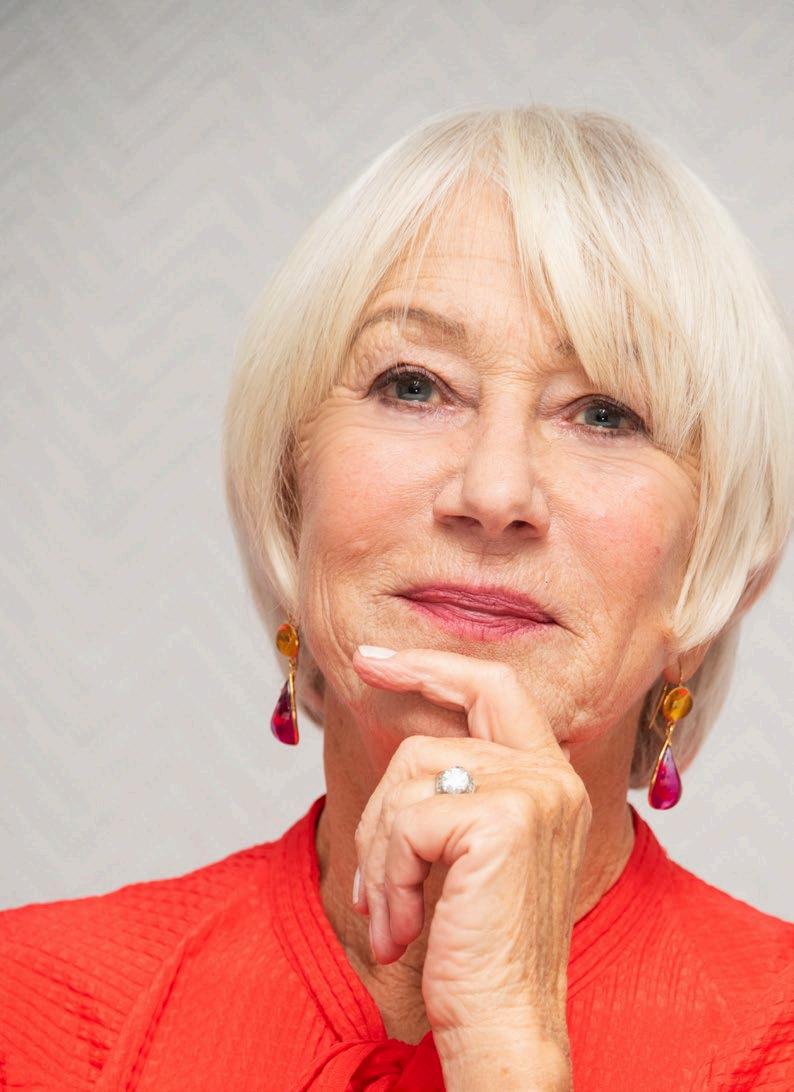

“I’m

Every three minutes a child like Pedro is born with a cleft. This number doesn’t change even during a global pandemic.
Pedro’s family fled an increasingly uncertain situation in Venezuela and moved across the border to a refugee camp in Colombia.
The two local hospitals only have the capacity to treat refugees in emergency situations, leaving even potentially fatal conditions like cleft untreated.
Pedro’s mother, Marbelis, is a quietlyspoken determined woman who would do anything for her young family.
Marbelis had all but given up hope of ever finding Pedro the medical help he so badly needed in Venezuela. For seven long years, she watched her little boy struggle, and no matter how hard she tried, there was little she could do to help him.
Pedro was fortunate to avoid the severe health problems that can be caused by cleft conditions, but he bears the emotional scars of having been badly bullied at school.
Thankfully, just a few weeks after the family had made a makeshift home in the April Third refugee camp, a local healthcare community worker identified Pedro and his need for cleft care, and his details were passed on to Operation Smile Colombia.
A few months later, Marbelis and Pedro travelled to the nearest medical mission, where after a comprehensive health evaluation, Pedro proved to be an ideal candidate for surgery.

Pedro’s operation went smoothly, and in just over an hour he was safely back in the recovery room. When Marbelis first saw him, she was overcome with emotion. “I ran in here and when I saw him, I started to cry, because he looked so beautiful.”
Since 1982 Operation Smile has provided hundreds of thousands of free, safe surgeries for those born with cleft, who could not otherwise access or afford medical care.
In addition to mobilising highly accredited medical volunteers, Operation Smile trains local medical personnel and partners with hospitals, governments and ministries of health to ensure that safe surgery is a right for everyone in need, not a privilege.
If you would like additional information and to find out how you can help, please visit: www.operationsmile.org.uk/Crisis or call 020 3475 5126
16 IT’S A MANN’S WORLD
Olly Mann learns a lesson or two from his son about toy appreciation
ENTERTAINMENT
20 INTERVIEW:
DAME HELEN MIRREN
The iconic actor on the perils of beauty, womanhood and her time in lockdown
28 “I REMEMBER”: DR EDITH EGER
The renowned psychologist and Holocaust survivor looks back on her complicated life and what it taught her HEALTH
38 OUR MYSTERIOUS SENSE OF SMELL
Leading researchers are unlocking facts about the least understood of our senses
56 DYNAMIC HEALTH DUOS
From fish and wine to salmon and yogurt, these foods deliver an even bigger health boost when consumed together

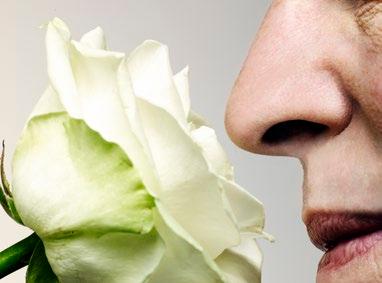
INSPIRE
74 PET CEMETERIES
Behind the fascinating tradition of grieving our beloved pets
82 SHRIMP-FISHING BY HORSEBACK
On the Flanders coast, a centuries-old tradition survives TRAVEL
90 DELHI DELIGHTS
Discover the chaotic beauty of the colourful Indian city



















Enlarges any object instantly
Huge 160% magnification

Fits over prescription glasses

you see everything cleaner, bigger and brighter...even in low light conditions!


These innovative glasses deliver instant magnification of up to 160%! Plus, the super bright built-in LED lights let you see every little detail even in the dark.
Already wear glasses? No problem! These magnifying glasses can be worn over your prescription glasses or contact lenses for extra magnification and clarity. You will see the difference instantly! Turn tricky activities such as threading needles, reading smallprint, hobbies and crafts into tasks that are easy and enjoyable. And, with the powerful built-in LED lights, you will be able to read in the evenings in bed or work in low light areas without straining your eyes.
Power Zoom Max lenses are scratch resistant and offer excellent sharpness, along with 160% magnification. Power Zoom Max suits everyone.
FREE OFFER! For a limited time only, order a pair of PowerZoom Max glasses with carrying pouch and we’ll send you another pair absolutely free! Yet that’s not all...every order also comes with a free pair of Aviator style sunglasses with their own hard carrying case. But hurry...stock is limited and is sure to sell out fast.
WARNINGS: Never look directly at the sun. Aviator shape sunglasses are designed for normal use under normal daylight conditions. Do not wear the sunglasses for protection when using machinery. Do not wear them inside buildings or at night.





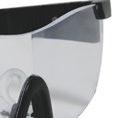

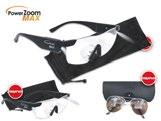







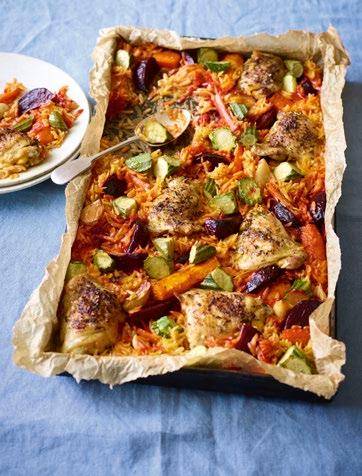
A Stiltz Homelift is an ideal and affordable alternative to a stairlift. You can now safely travel between the floors in your home while keeping your stairs the way they have always been.
A Stiltz Homelift can be installed into almost any room in your home. A Stiltz is uniquely compact with the smallest model taking up just over half a square metre – now that IS discreet. The homelift plugs directly into a standard domestic socket and uses less power than boiling a kettle. The homelifts run on self-supporting rails so there is no need to drill into walls and the motor is fully self-contained within the lift car. Neat.
While some Stiltz customers have an immediate need for a homelift, others are looking to future-proof their existing home for when the stairs do eventually become a challenge.
Don’t go through the unnecessary expense and emotional upheaval of moving
house or the disruption of adapting your home for downstairs living. Save money instead; live comfortably and independently in the home you love for as long as you want, with a Stiltz Homelift.
“We’ve had our lift for 2 years and were so impressed with how it was fitted from our hallway to our landing in what at first appeared to be an impossible space. And in such a short time.”
Mr. EamesStiltz are proud to hold the highly-regarded Which? Trusted Trader status meaning they are a reputable, established and trustworthy company. Stiltz customers love them too, rating them ‘Excellent’ on Trustpilot. They use their own teams of expert installers, so you can choose a Stiltz Homelift with complete peace of mind, knowing you and your home are in a safe pair of hands.
“Excellent product installed by polite and very competent tradesmen. Fits perfectly into my home. Made a huge difference to my ability to live independently”.
Mark via Trustpilot

Elegant, practical and discreet. A Stiltz Homelift will transform your home and your life.
A Stiltz Homelifts Consultant can visit your property to help you plan the best location for your homelift. They can also answer any questions you might have, as can any of the friendly, UK-based phone team. So, why not give your lifestyle a lift with Stiltz. Call FREE today.
•
•
•
•
•
•
•
SENIOR EDITORS
Anna Walker, Eva Mackevic
EDITORIAL ASSISTANT Jessica Lone Summers
ART DIRECTOR Richard Cooke
ADVERTISING Jigs Pankhania
HEAD OF FINANCE Santwana Singh
FINANCE MANAGER Irving Efren
MANAGING DIRECTOR Julie Leach
CHAIRMAN Gary Hopkins
subscriber enquiries, please
WE PAY...
£50 for the star letter and £30 for regular letters.
Email readersletters@readers digest.co.uk or go to readers digest.co.uk/contact-us
WE ALSO PAY...
£30 for the true stories, anecdotes, jokes in Laugh! and You Couldn’t Make It Up…, and contributions to end-ofarticle fillers and My Great Escape.
Email excerpts@readersdigest.co.uk or go to readersdigest.co.uk/contact-us
We cannot acknowledge or return unpublished items or unsolicited article-length manuscripts. Do not send SAEs. Article-length stories, poetry and cartoons are not requested.
TRUSTED MEDIA BRANDS INC (USA)
President and Chief Executive Officer
Bonnie Kintzer
Editor-in-Chief, International Magazines
Bonnie Munday
number below
Contact Customer Services for renewals, gifts, address changes, payments, account information and all other enquiries. Call 0330 333 2220* or email customer_service@readersdigest.co.uk
Reader’s Digest is also available in audio and accessible etext editions from RNIB Newsagent, for blind and partially sighted readers. Call the RNIB Helpline on 0303 123 9999 or visit rnib.org.uk/newsagent
Annual subscriptions are available to be delivered monthly direct to your door. For our latest offers please visit readersdigest.co.uk/subscribe Or telephone us today on 01778 392461
Gift subscriptions also available. UK rates may vary. Overseas rates: Republic of Ireland €50, Rest of the World €60.
Packed with over 250 pages of photos and stories, MAF’s colourful new coffee-table book will take you on a flight through the decades from 1945 to the present day!

From the ashes of WWII, a handful of Christian airmen and women dreamed of using aircraft to deliver peace and healing to isolated communities.
Through the pages of Above and Beyond , you can travel to the furthest corners of the world to encounter hidden tribes, lifesaving partnerships, and inspiring stories that span seven decades of MAF’s inspiring history!
Scan the QR code or visit our website below to order your discounted copy.
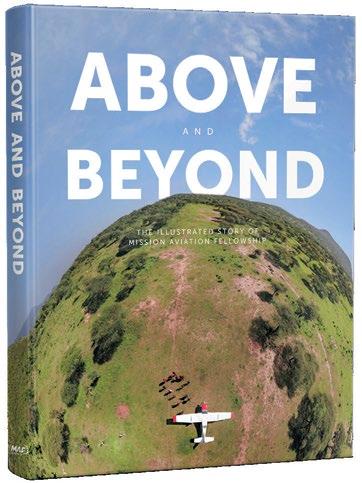


Our “I Remember” feature is a highlight for me in most issues—a place for celebrities to take us with them on a trip down memory lane, reminiscing about the highlights of their lives and careers. This month, however, we decided to do things a little differently. May’s star isn’t an actor or singer, but Dr Edith Eger: Holocaust survivor and psychologist specialising in post traumatic stress disorder. Hearing Dr Eger’s account of her time in concentration camps including Mauthausen, alongside her relentless positivity is something truly special. Eger’s story is one of extreme endurance, and the power of the human mind to not only survive, but thrive after escaping a darkness most of us can only imagine. I urge you to read her story: it’ll leave you humbled, thankful and in utter awe.
Worcester will always have a special place in my heart. It was my first UK home when I moved to the country over a decade ago. The memories of sunny days spent on the lush cathedral grounds, the twinkling lights of the Victorian Christmas Fayre and cosy evenings with friends at the local pub make my heart skip a beat to this day.

Worcester is a gorgeous city where everyone treats you like family no matter who you are and on p66 we pay tribute to its beauty and character by chatting to some long-time residents about what made them fall in love with their city.
And on p98 we venture up north, to Halifax in West Yorkshire, where our reader Brian Conduit admires the beauty of the grandiose Piece Hall and contemplates its importance to the 18th-century wool trade.
facebook.com/readersdigestuk
twitter.com/readersdigestuk
@readersdigest_uk
You can also sign up to our newsletter at readersdigest.co.uk
Reader’sDigestis published in 27 editions in 11 languages
We pay £50 for Letter of the Month and £30 for all others
“Loneliness, Our Other Health Crisis” was an upsetting read. I couldn’t agree more that maintaining regular social connections is essential, not just for our self-esteem but also our all-round health. There is definitely a stigma surrounding loneliness, and older people tend not to ask for help because they have too much pride. The problem is the feeling of loneliness or being detached from others is not just a human emotion, it is a complex emotional response to a lack of companionship. And, sadly, during the pandemic, loneliness has increased. People are engrossed in virtual social communities and networks and don’t have the urge to stay in touch with family, friends or neighbours.
Olivia Newton John struck a chord when she reminded us that if we think negatively, it will affect our health and wellbeing. It seems easier, in these difficult times, to complain or criticise, but
During the pandemic and even before then, I’ve been calling or phoning three elderly neighbours, even if it’s just to take some reading material to them, ask if they want groceries or just to have a chat on the doorstep (socially distanced, of course). All three neighbours live on their own. It’s no hardship to me. One neighbour I phoned recently was on the phone for 55 minutes. She did most of the talking and I listened. She thanked me and said she hadn’t spoken to anyone for three days. Humans are born wired for connection—it’s in our DNA. If we know someone is lonely, we should all make an effort to prevent that. It’s not rocket science.
RIKKI MCMULLEN, Cheshireshe’s right. If we bite back our negative comment and focus on the good, if we stop finding fault with others and instead emphasise what they are doing well, then we will feel stronger and happier. Those around us will feel
appreciated and respond positively. It is difficult to stop being negative, but I am trying to be like her and to emphasise the positive. I am amazed at how much better I feel when I do.
PENNY GLENDAY, Dundee
I really enjoyed reading “My Dog the War Hero” and was rooting for Dyngo all the way. What an extraordinary life and what a huge adjustment to have to make—from war hero to civilian pet. I have such respect for Rebecca Frankel for giving him a home and overcoming so many challenges along the way. We’ve just added a puppy to our family and are finding her wonderful and infuriating in equal measure. However, a few accidents indoors and a penchant for welly boots now seem like very mundane concerns.
I know, like Rachel did, that all it’s going to take is a bit more time—because if Dyngo can settle into civilian life, then our puppy will certainly settle into our family, and our shoes will once again be left to mind their own business!
It’s such a privilege to share your life with a dog and I agree with Rachel that the pros always outweigh the cons. The challenges, be they big or small, are never insurmountable.
JENNIE GARDENER, BathI agree with Nadia Sawalha’s point in “If I Ruled the World” about cyclists being accountable for their actions. On roads, cyclists, cars and other automobiles are all responsible for accidents. I think roads should be improved for cars and those who pay their road tax while cyclists should have more cycle paths created, instead of everyone being in the same place. This worked in the past when roads were quieter, but times have changed, there is now too much traffic and less safety. Cyclists would be safer and healthier away from the pollution and car owners would be less stressed without the dangers of overtaking cyclists. In time, having appropriate cycle paths may encourage car drivers to ditch the car, get a bike and reduce pollution, helping the climate and improving safety as a result.
 GERALDINE SYSON, Glasgow
GERALDINE SYSON, Glasgow

With the national lockdowns and restrictions that we’ve all experienced since the pandemic began, you might be rethinking many areas of your life, including your plans for retirement. We understand that your priorities may also have shifted, perhaps towards retiring early and fulfilling your long-held dreams.
Retiring early is not always easy however, as there are big changes involved, especially when leaving work and trying to live on a pension income. If you’re concerned about this, there are options available that could help you live the comfortable life you’re aiming for.
One of these options available is known as a Lifetime Mortgage. This type


of mortgage is designed specifically for homeowners that are aged 55 or over and could help you to release some tax-free money from your home. By taking this tax-free sum that would normally be tied up in your home, your savings could stretch further than you think.
With a Lifetime Mortgage, you could use the money to pay off your existing mortgage. The best part about using a Lifetime Mortgage in this way is that they don’t require you to make any monthly payments. Instead, the amount borrowed, plus interest, is paid off with the sale
of your home after you pass away or enter long-term care. Be aware though that borrowing in this way could reduce the value of your estate and affect your entitlement to means-tested benefits.
With no need to make monthly payments, you can free up more of your budget to use on what matters to you. What’s better, is that without the stress of budgeting for a mortgage, you can be one step closer towards an early retirement.
If you’re planning to retire early, then you may have some grand plans to fill your newfound time. Whether that is to travel around the UK, or just to live comfortably, you could do so in style with a brandnew set of wheels funded with a Lifetime Mortgage.
If you’re interested, then you can call the Reader’s Digest Equity Release Information Team today. They are on hand to answer your initial questions and to give you an estimate of the amount of tax-free money you could receive. n



What do you get when you combine cross-stitch and graffiti? These fantastic murals! Portuguese artist Ana Martins witnessed her grandmother cross-stitching and realised that both her graphic design studies and grandma’s tablecloth were based in pixels. Now the young woman‘s artwork can be seen on the streets of Portugal. The one pictured is on the wall of a nursery in Apelação near Lisbon and is titled “No Glass to Hold Me Back“. This amazing work is 7,5 x 5m and uses 10km of wool and 15,000 screws!
Photo: © P icture A lli A nce / solo s yndic A tion / Jenny Good A ll
A slice of humble pie is on the menu for Olly Mann in this month's column…
The best toys of your childhood are everybody else’s. When I think back now to the impressive collection of playthings in my playroom (I had a dedicated room, for heaven’s sake), my heart does not start racing. Yes, there was the Matchbox garage passed down from Mum, and my beloved pop-dice game, Frustration, and my vintage toy soldiers and wooden fort. I can visualise these things in detail, so presumably spent many happy hours with them. But it’s only when I get to remembering Ben Walker’s

Olly Mann presents Four Thought for BBC Radio 4, and the award-winning podcasts The Modern Mann and Answer Me This!
space hopper, or Neil Savla’s rollerskates, or Olly Sloboda’s copy of the boardgame Mysteries of Old Peking… only then do I feel a true pang of nostalgia. My friends all had cooler toys than me.
Except, of course, they didn’t. Space hoppers look cool, but are only really ridable for three minutes, before you get a sore bum. Mysteries of Old Peking was, frankly, racist, with comedy character names like "Han Dee" and "Sly Lee"—although, admittedly, only to the same degree as most TV comedy in those days. And, as for the roller-skates: I made such a fuss about Neil Savla’s pair that my parents got me some for my eighth birthday, adorned with The Real Ghostbusters, and then I promptly fell on my face and was prohibited from using them anywhere except the patio.


I convinced myself, if only I’d been gifted a pair of Neil’s Ninja Turtles skates, I would have somehow been on track for Olympic glory. I now see this was apocryphal.
I bring this up because my son was recently lusting after one of his friend’s toys: a plasticky gadget called a Stomp Rocket. It’s marketed as a "science toy", because it (sort of) teaches kids about air pressure and aerodynamics, but, really, it’s just a big foam rocket launcher that’s good for groups of children to play together, as there’s a level of oneupmanship about who can jump the hardest, and get the rocket to go the highest.
Our friends Ben and Nicky brought theirs along to the park one day, and our son Harvey immediately became obsessed by it, continuously badgering me to buy one for him. I steadfastly refused, partly because I thought, He’d only want to play it with their kids anyway, so he might as well play with their one, and partly because I thought, Blimey, 20 quid for a plastic tube and some foam! It’s not quite Twister-level profit obscenity (£17.99 for a polythene sheet and a cardboard spinner), but it’s close—if I really put my mind to it, I could probably create a replica with a bottle and hose pipe.
Furthermore, I was concerned that
if I acquiesced to the Stomp Rocket demands, Harvey would soon additionally
be asking for the same remotecontrolled car and drone that Ben and Nicky also sometimes bring to the park with their kids (their outdoor toy arsenal is strong), and a copycat combo would set me back £300. So, my wallet stayed shut, and I told Harvey that if I bought him a Stomp Rocket, he’d soon be bored by it anyway.
But then I thought, Ah, perhaps that £20 would be well-spent if it taught him a valuable lesson. None of that weirdy-beardy STEM engineering nonsense! But, instead, this vital admonition: Do Not Ye Covet Your Friends’ Plastic, Lest It Reveal Unto You Its Mundanity. If I bought Harvey his very own Stomp Rocket, he’d tire of it and realise quickly that his own toys are actually just as good as everyone else’s. Something it took me 30 years to appreciate!
So, one day in February, I was idling away in Halford’s—because that’s how thrilling our recreation options had become, in full lockdown—and there it was: an endof-aisle display full to the brim… with Stomp Rockets. It seemed churlish not to.
Harvey was THRILLED. "Of course we can go to the park, and test out
your Stomp Rocket," I urged him; quietly rubbing my hands, certain I was about to smack him in the face with the futility of materialism.
But that was two months ago. And every weekend since, whatever the weather, he has asked to play with his Stomp Rocket. His familiarity with the toy has not—yet—bred indifference, but the opposite: he is now developing ways of "hacking" the angle and airflow to create maximum reverberation and blare.
Unlike the £120 Scalextric we got him for Christmas, the £20 Stomp Rocket does not keep breaking down, causing Daddy to
be consumed by a vortex of endless YouTube demonstrations about braid-replacing.
Nor does it require plugging in. It is portable. It is waterproof. It is, I’m forced to admit, wholesome family fun (Granddad’s run-up and stomp launched a 200ft blast over the treetops; a remarkable display that will linger in the memory for months). And—as you can only use it outside, must take turns to use it, and it’s best viewed from a distance—it’s also the perfect socially-distant toy for 2021.
God, I really hate it when my kids are right. n
Can you name the famous film based on its soundtrack?
1. "I Will Always Love You" by Whitney Houston
2. "Everything Is Awesome" by Tegan and Sara
3. "Hold Me, Thrill Me, Kiss Me, Kill Me" by Mel Carter
4. "Men in Black" by Will Smith
5. "I Don't Wanna Miss a Thing" by Aerosmith
6. "The Power of Love" by Huey Lewis and the News
7. "Deeper Underground"
“I’ve
Dame Helen Mirren is the very essence of “worth it”. The national treasure and L’Oreal ambassador explains why that message is as important today as ever, and how she wants to rebrand beauty
Say the words, “I’m worth it” out loud and I defy you not to flick your hair over one shoulder, lift your chin up a fraction and give an imaginary camera your most promising smile. Because as beauty taglines go, L’Oréal Paris’s is the most famous of them all, rising above mere slogan to be part of our everyday lexicon. This year marks the brand’s 50th year of championing and celebrating a woman’s worth and it’s for this anniversary that I’m granted a rare interview with one of the brand’s ambassadors, Dame Helen Mirren.
Speaking to me from her US home in Lake Tahoe, on the border
of California and Nevada, where she lives with her film director husband Taylor Hackford, Mirren’s mind isn’t far from her British roots. “There’s a major lockdown in England, I hear?
I talk to my sister frequently and my friends in London. It’s extraordinary.” The 75-year-old Academy Award winner tells me about her life over the past year. “My husband and I have been married for 30-something years, you know, a very long time. But in all that time because of the nature of both of our work we’ve always been looking at suitcases, at packing. The suitcases are always on the floor ready to be packed or unpacked. We have never spent this amount of time together,” she laughs.
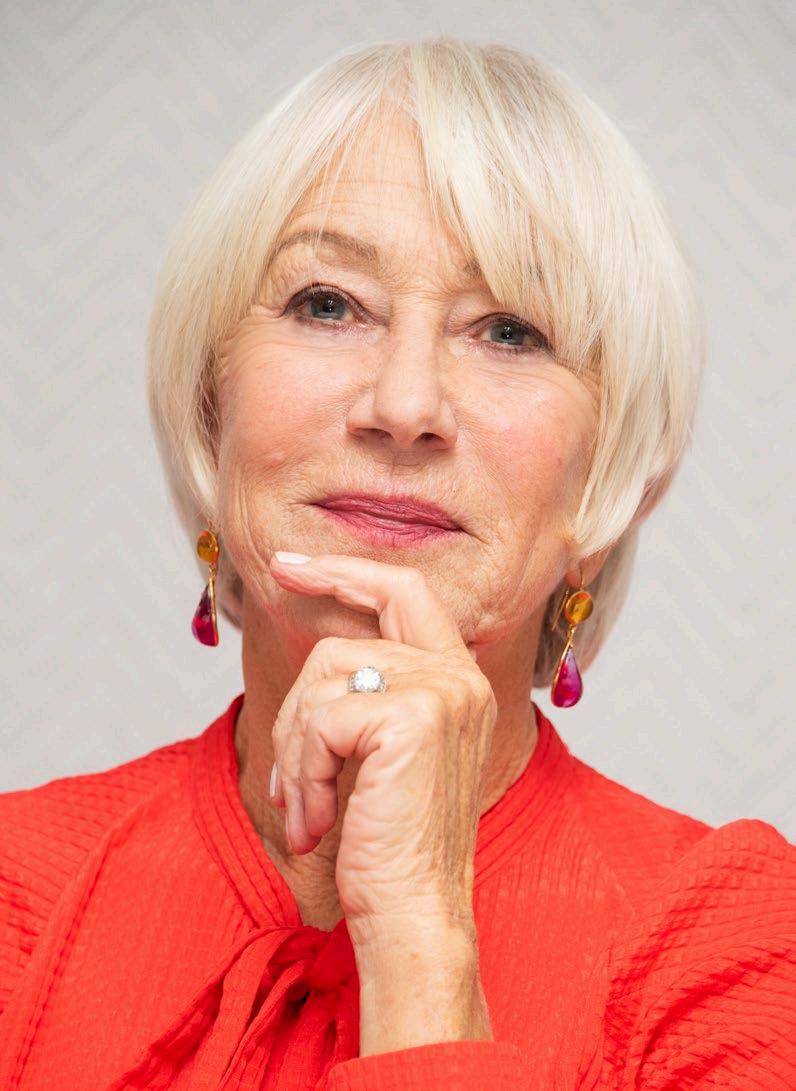
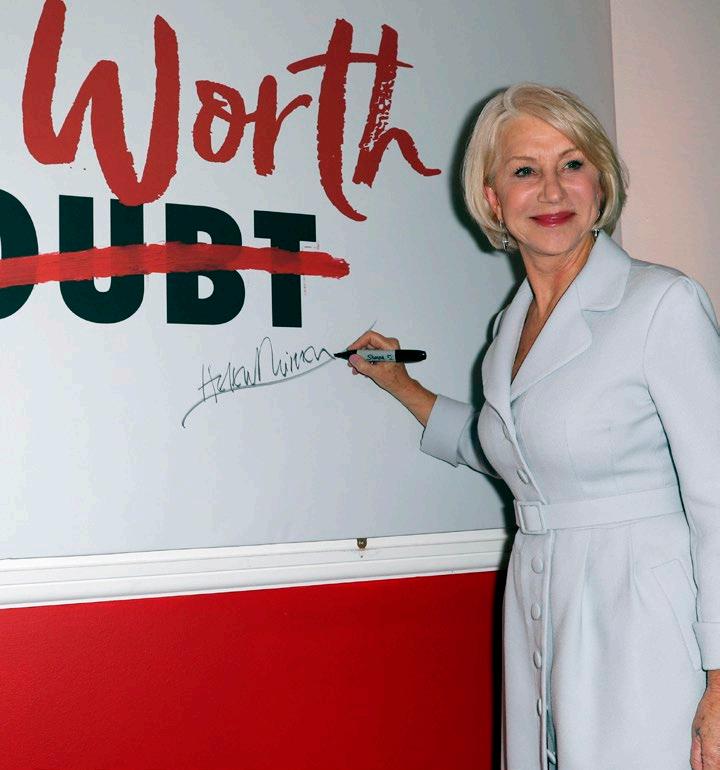
As I come to learn over our conversation, Mirren sees the positives in most situations. “[The past year] could have been disastrous but has actually been fantastic,” she says. “It’s been really great to just sort of have what most people have. You know, normal, regular, repetitive lives, but comfortable lives. So it’s
been a wonderful way for the two of us to bond, in a weird way. I think it’s been a very bonding experience.”
From the silver linings of a strange 2021, we move on to talking about the moment, in 1971, when a 23-year-old copywriter in Manhattan, Ilon Specht, put pen to paper and
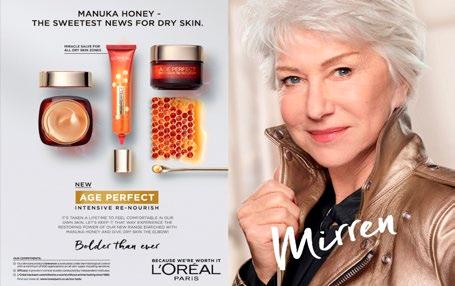
“IT’S HARD TO DESCRIBE WHAT THE 1970S WERE LIKE FOR WOMEN… IT WAS A TERRIBLE TIME”
wrote the tagline “I’m worth it” for a L’Oréal Preference hair colour advertisement. Twenty years later, Specht told The New Yorker how frustrated she had been with the way women were objectified in the ads of the time. “My feeling was that I’m not writing another ad about looking good for men,” she said. “I sat down and did it, in five minutes. It was very personal. I can recite to you the whole commercial, because I was so angry when I wrote it.”
It resonated immediately, particularly at such a pivotal time for the women’s rights movement. “It’s hard to describe what the 1970s were like for women,” Mirren explains today, and I can practically hear her shaking her head over the phone. “The 1970s were a terrible time for women. It was the worst time. We
came out of the feminist revolution of the 60s and suddenly it all went away. Women were really objectified, I felt, more than before. Objectified and not given opportunities. I’m actually really cross I had to live through the 70s as an adult. I wish I had been, like, five or something,” she laughs. “So what a stroke of genius and inspired moment for this young girl to write a line that was so simple and gave you a sense of identity. As if to say, I’m a woman, I’m me, and I’m a strong voice in this room and this world. It was borne out of anger and resentment and crossness with all the men. To me, it incorporates the concept of absolute equality.”
Did Mirren ever have moments of having to prove her worth?
“Sometimes,” she says. “Sometimes I

“ PRIME SUSPECT EXPLAINED TO THE WORLD WHAT WOMEN WERE UP AGAINST”
had to stand my ground in my career. I was always a little bit bolshy and a bit annoying, I’m sure, as a younger woman. But I was so lucky in my upbringing: my parents absolutely felt that women as much as men could go anywhere they wanted and do whatever they wanted.” She does recall one moment, however, when she was a girl. “My mum was once ironing a shirt, and said, ‘Come here, I’d better teach you how to iron a shirt.’
I said, ‘No, Mum, I don’t want to learn how to iron a shirt, I’m not interested.’
She replied, ‘Well, believe me, one day you’ll find yourself ironing shirts.’ And at the time I remember thinking, I will never iron a man’s shirt. Why should I? But don’t get me wrong, my parents were always encouraging us
and opening our minds to what was possible, rather than just, ‘You’ll get married and have kids’. For an awful lot of women in my generation, that’s how they were brought up.”
Mirren tells me how being cast as DCI Jane Tennison in Prime Suspect in 1991 was “for women everywhere”, despite many at the time thinking a show with a female lead wouldn’t work. “The success of Prime Suspect was a step in the right direction, partly due to the fact that although women in other professions had been making real progress, they had to pay a price for it. They had to put up with an enormous amount of prejudice and antagonism towards them in the 90s—and they had to shut up and put up with it. They couldn’t speak about it because

if you did you would immediately become a ‘whiner’ and it weakened you, so they had to stay incredibly strong. But Prime Suspect explained to the world what women were up against.”
It certainly struck a chord, and Mirren went on to win three TV Baftas for the role. In 2014 she received the Bafta fellowship for lifetime achievement. She says how “upsetting” it is to see the effects of
the pandemic on London’s theatre industry. “It’s the live performers, the ballet dancers, the singers— all of that world that is such a wonderful part of London has been so devastated. But it will come back with a vengeance I believe. People will be so ready for it.”
L’Oréal Paris had quite the coup in signing Mirren—even if she does take exception to the term “beauty”.

“It immediately takes 90 per cent of us out of the picture,” she says, and there’s that head-shake I can hear again. “Because only a small percentage of us are what you would call ‘beautiful’, it’s just a ‘thing over there for those people’. There are great athletes and great artists, we can be all kinds of other things and we don’t just have to be beautiful. And that’s fine. It’s great that humanity has such variety. To me, the word beauty is always pushing you towards being more beautiful, but that’s not what it’s about. Your worth is not about beauty at all, it’s about having agency.”
I ask Mirren what she’d prefer to call it. “I like the word ‘swagger’,” she laughs. “I want to go to the swagger department in Boots,” and then, calling out an imaginary request in
A pink-haired Mirren attends the premiere of Les Plus Belles Annees D’Une Vie during the 72nd Cannes Film Festival. Right: at the premiere of HBO’s Catherine the Great
said chemist: “‘Excuse me, where can I find a little bit of swagger for today?’ Let’s call it the swagger industry, not the beauty industry.”
So what are Mirren’s go-tos to get swagger? “I have to say, I love make-up,” she tells me passionately. “I can spend hours putting make-up on, I love all of that stuff.” She’s a fan of budget beauty finds, “not the highend stuff. I still get terribly excited when I try new drugstore make-up like finding a new eyebrow pencil. I get so excited when I get home and can’t wait to open it!”
As for her current go-to product, she loves castor oil. “This is no bulls**t, I have it in my hand right now,” she tells me. “It is brilliant. You just need a tiny amount which is great for your hair. I’m too lazy to colour my hair, so I just use a good

“WE CAN BE ALL KINDS OF OTHER THINGS, WE DON’T JUST HAVE TO BE BEAUTIFUL”
shampoo but now and again I’ll dye it pink if I feel like it.”
I ask for Mirren’s final piece of beauty advice. “Don’t smoke. If it did to the outside of your body what it was doing to the inside, you would stop instantly, no matter how addicted you were. The trouble is, smoking gives you swagger!” she laughs. “Ha! But that’s really not a good swagger eventually.”
The refreshing exception to the rule when it comes to beauty brand ambassadors, Mirren embodies exactly what that original tagline was about. “The message behind our legendary slogan is women’s
empowerment,” says Delphine Viguier-Hovasse, global brand president of L’Oréal Paris, and the first woman at its head. “For the past five decades, we have empowered women through our beauty products.”
“The progress of women has moved on immeasurably over the past 50 years,” says Mirren, “but in the last year, so much has fallen on women’s shoulders such as homeschooling, as well as cooking and cleaning. It is better than it was, but unfortunately women are still bearing the brunt, that’s how it still shakes down. So I suspect we’ll still need to say ‘We’re worth it’ for another 50 years to come.” n
Ireland has the oldest average age at first marriage in the world at 35
Source: cso.ie/en
Dr Edith Eger rose from the ashes of Auschwitz to become a renowned psychologist and author. Throughout everything she has faced, the 93-year-old has held on to hope and remained resilient, calling each challenge and circumstance a gift. Now, with two New York Times bestsellers and the legacy of a multi-generational family, Dr Eger reflects on her journey toward happiness and acceptance


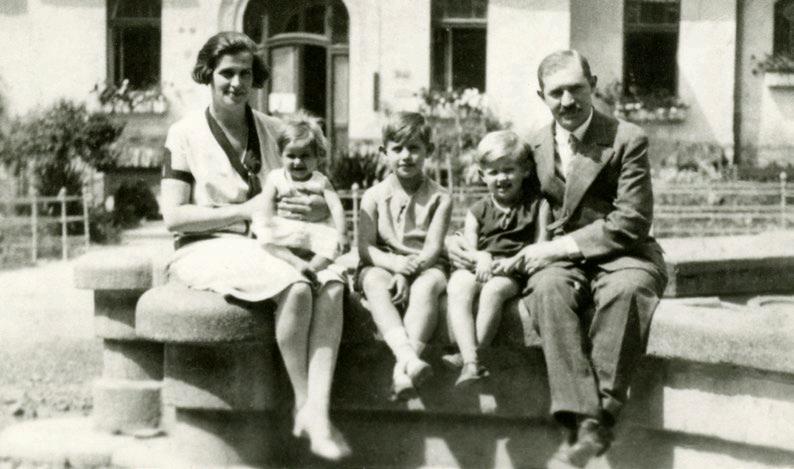
…MY MOTHER TELLING ME, VERY SERIOUSLY, "I’M GLAD THAT YOU HAVE BRAINS BECAUSE YOU HAVE NO LOOKS". I had two beautiful sisters, Magda and Klara, both older, and I took what my mother said to heart, and I was not angry with her. I wanted to prove how smart I was, so I did really well in school. Just because someone tells you that you’re not pretty, or you’re not smart doesn’t mean you have to give up, because the only one you have for your lifetime is you.
…MY FIRST BOYFRIEND, ERIC. He told me that I had beautiful eyes and
beautiful hands when we were separated at the transport to Auschwitz. We met in Kosice when I was 14 and we were together for two years before being taken to Auschwitz. He was on a different transport on the same day. Years later, I was told by his family that he had been shot the day before my liberation on May 4, 1945.
…I WOULD ASK MY FATHER FOR MONEY. I knew to do it when he was playing billiards with his cronies because he would want to save face in front of them. He would always be more generous then and so I would
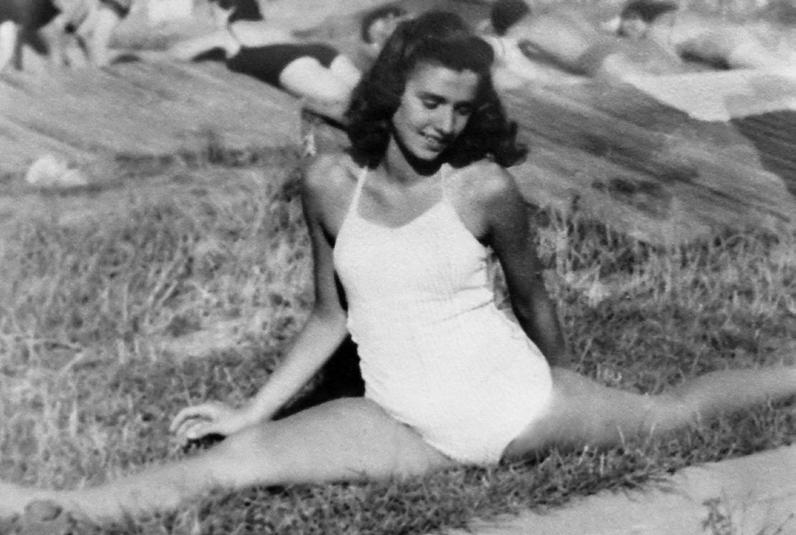
make sure to ask him for things during those moments. Timing is everything.
…BALLET AND GYMNASTICS WERE THE MOST IMPORTANT THINGS IN MY EARLY LIFE. They had so much meaning for me, and I think they also helped to save me. In Auschwitz, I could not change what was outside of me; they could throw me in a gas chamber at any minute. But at night, I could escape into my head and be dancing. I could be with my boyfriend and imagine when I would see him again.
…DANCING FOR DR JOSEF MENGELE. He was also known as
the “Angel of Death.” He came to the barracks and wanted to be entertained. The girls I shared my bunk with pushed me in front of him because they knew I was a dancer. He told me to dance for him while he selected others to go to the gas chamber. I was dancing for my life; in my mind the music was Tchaikovsky and I was dancing Romeo and Juliet at the Budapest Opera House.
Afterwards, he gave me a piece of bread. I could have gobbled it up, but I climbed up to the top bunk, to my friends and shared it with them.
Later, on the death march from Mathausen to Gunskirchen, I was beginning to fail and if you stopped walking, you were shot right away.
With her husband Béla (Albert) Eger, a fellow survivor
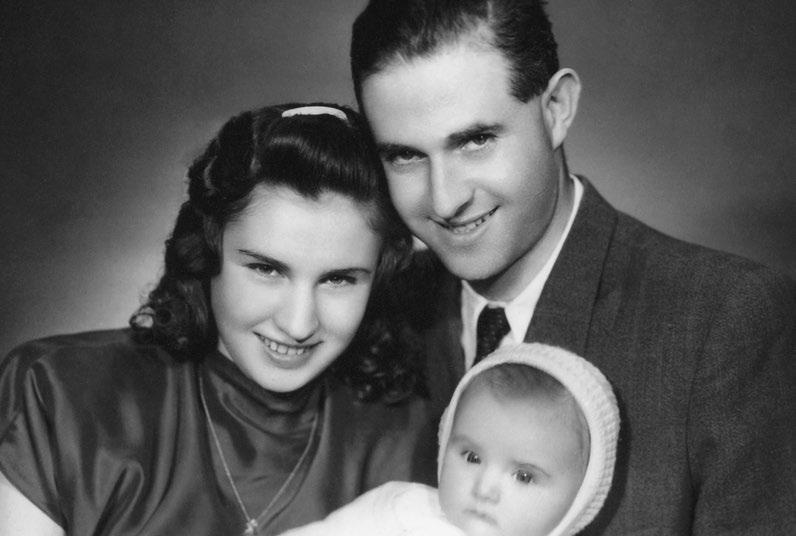
I was slowing down, so the girls that I shared that bread with almost a year before made a chair with their arms and carried me. This is the most important thing I learned from this time—collaboration and cooperation, not competition—and I have taken that through my whole life in everything I do.
…FEELING SO THROWN OUT, SO FORGOTTEN. I wondered, “Does anyone know that I’m here? Does anyone know about children being thrown into gas chambers?”
I would pray for the guards, because I thought that they must have been brainwashed because we are born with love, with joy, born
with a passion for life. We are taught to hate.
BY MY NAME. I would say, “I’m Klara’s sister, for instance, because she was famous for playing the Mendelssohn violin concerto.
I spent a lot of my childhood alone, and I was painfully shy, except for when I was dancing, of course. But perhaps everything is planned for us and I learned how to be alone because in Auschwitz everything was taken away from us.
WHEN I FELT A HAND HOLDING
MY HAND. I looked up—I’d never
Edith with her daughter Marianne in New York

seen a man of colour in Hungary. And when I looked further, I saw his eyes and he was crying. He gave me some M&Ms. Of all the things that happened there, it felt like a miracle in that moment.
…IT WAS SO VERY DIFFICULT when people would talk to me and ask me if I was OK, I would say yes. I felt like a widow, like I had lost everything, but still, I didn’t want them to feel sorry for me. So, I created what we call today, the ego, the false self.
…WHEN I CAME TO AMERICA, I just wanted to be what we called a “Yankee Doodle Dandy.”
I wanted to be like everyone else. If you asked me who I was, I would say, “Who do you want me to be?” I became a very successful schizophrenic [she laughs] because I just wanted to be like you. I never told anyone that I had been in Auschwitz until I read Man’s Search for Meaning by Viktor Frankl.
…WHEN I MET VIKTOR. I had written an article for a local paper when I was living in El Paso, Texas in the 1970s about Dr Frankl. It was titled, Viktor Frankl and Me and somehow, it made its way to him and he invited me to come and meet him in San Diego where he was teaching at the United States International

University. When I read his book, I wanted to write ten more pages for each one he wrote—he had gone through the same experiences and he used the same mechanisms to survive in the camps that I had, but from a different perspective because of his age.
He described how he would close his eyes and imagine that he was in Vienna lecturing about the psychology of the concentration camp, just like I’d done when I had to dance for Dr Mengele.
…I WAS SO HUNGRY TO LEARN. I had a friend who was a professor at the University of Texas, El Paso. I didn’t have a diploma, but he fixed it somehow so that I could be a
provisional student. I graduated cum laude four years later and then I went on to get my PhD in Clinical Psychology.
Learning and thinking had always been a refuge for me when I was young, so school fed that part of me that needed intellectual comfort. My curiosity is what kept me alive in Auschwitz, and it’s what kept me going after moving to America. I’ve always wanted to know what was going to happen next and wanted to learn as much as I can about that.
…I LOVED GETTING TO WORK WITH PATIENTS. What I always want to do is to create an atmosphere for my patients: I want

them to feel perfectly safe to identify and feel any emotion they have, to know that is just what they are— emotions—and when we allow ourselves to feel our pain and honour it, we become stronger. Don’t call me a shrink, call me a stretch! I want to stretch your comfort zone and become stronger.
When my first book, The Choice , was published and I visited my grandsons, there it was on their coffee table.
In that moment, I knew that the story of my parents would be carried forward by their generation and they would also be ambassadors of peace, following in my footsteps.
…RETURNING TO AUSCHWITZ WAS REALLY THE BEST THING FOR MY HEALING.
To go back to the lion’s den, look the lion in the face, feel my rage and assign the guilt to the perpetrators was imperative to becoming who I am today. I was also able to say goodbye to my parents.
Every day, I work to honour the pain that I carry from Auschwitz; it lives right here in my heart. I don’t let it control me, though.
I acknowledge it and I move on. I call it my cherished wound.
Part of me was left in Auschwitz, but not the better part. n
As told to Valentina Valentini
The gift of a lifetime

Don’t think of it as a lockdown, think of it as an opportunity.
Don’t think of it as a lockdown, think of it as an opportunity.
To settle down in the company of LifeBook, the world’s leading autobiography and memoir service, tell the story of your life and turn it into a beautiful hardback book.
To settle down in the company of LifeBook, the world’s leading autobiography and memoir service, tell the story of your life and turn it into a beautiful hardback book.
Your chance to create a unique piece of family treasure to share with generations to come.
Your chance to create a unique piece of family treasure to share with generations to come.
And it couldn’t be easier or safer.
And it couldn’t be easier or safer. How easy, how safe? Find out at lifebookuk.com/lockdown or call 0808 278 8477.
How easy, how safe? Find out at lifebookuk.com/lockdown or call 0808 278 8477.
Now is the time to tell your story.
Now is the time to tell your story.
The world’s leading researchers are unlocking facts about the least understood of our senses
by Lisa Fields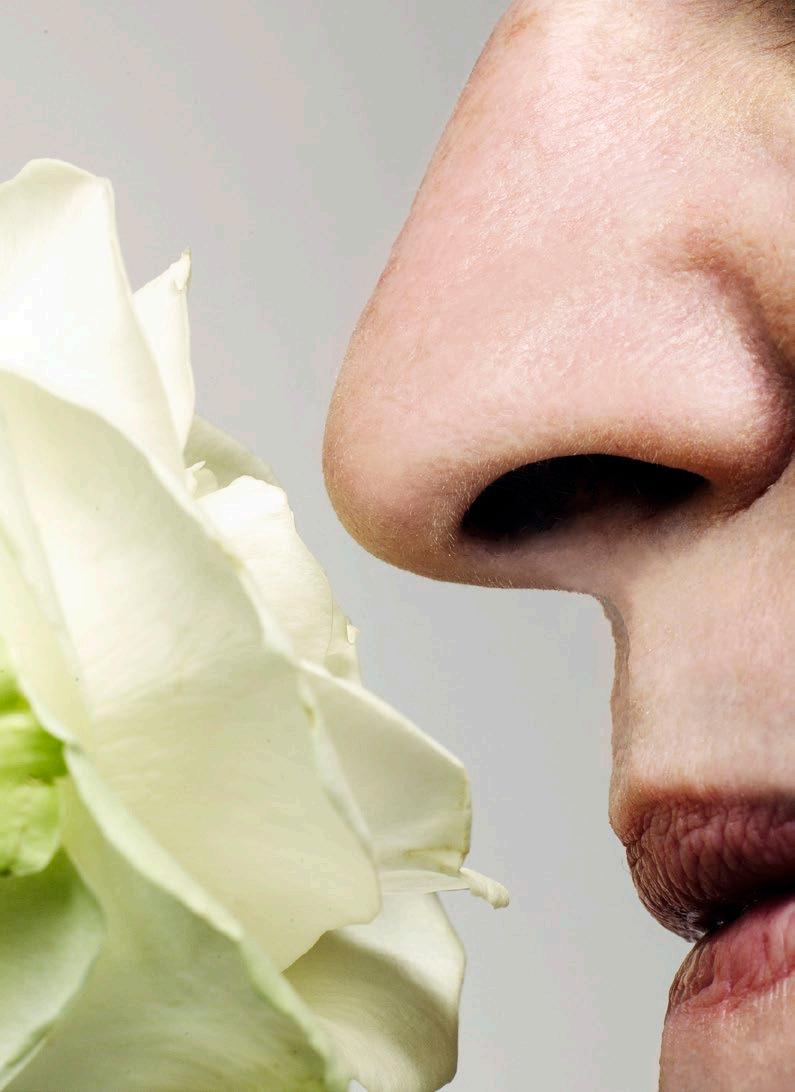
Your sense of smell is largely responsible for your ability to taste food. “Flavour is really an integrated experience that combines what happens on your tongue—that’s sweet, sour, salty, bitter, spicy—with smell,” says Asifa Majid, psychology
FOR MANY PEOPLE, A FADING SENSE OF SMELL MAY BE JUST A NATURAL PART OF AGEING

professor at the University of York. “When you put something in your mouth, the molecules go into your nasal cavity. Your tongue might be able to tell that there’s fat in that chocolate, and that’s something the brain finds very rewarding, but the formal chocolate experience comes from all the molecules going into your nose.”
Women out-perform men when both groups are asked to identify a certain number of scents. That holds true across all age groups. “This could be due both to women being better able to perceive the smell and women being better at verbalising the odour—that is, providing the odour with a verbal label,” says Erika Jonsson Laukka, senior researcher at the Karolinska Institute’s Ageing Research Centre in Stockholm. Her research shows that when people were asked to memorise eight scents (including garlic, fish, turpentine, and lemon) and were then given a scent test, which included some of the original scents and some new scents, the women were better able to identify whether or not a scent was one of the ones that had been memorised. Women were also better at identifying the scents by name.
After age 50 or so, our sense of smell starts to decline. “This loss accelerates as people get older,”
says Dr Thomas Hummel, director of the Smell and Taste Centre at the Technische Universität, Dresden. “Among people over 50, a quarter have a loss. In people over 80, about a third will have no olfactory function at all. But half of those over 80 still have a good sense of smell.”
People often think that those who are blind, deaf, or have lost their ability to smell will have another sense heightened, but according to research, this is merely an old wives’ tale. For example, Dr Hummel has studied the sense of smell in blind people and has not found the sense to be heightened.
“That’s a little bit of a myth,” Dr Hummel says. “We’ve been looking at this in very large groups—up to 40 people—with congenital blindness, and people with acquired blindness, and they are not better in their sense of smell. There may be individuals who are really good. But when you look at larger groups, you don’t see it. It’s not there.”
“Every time we have a cold, a toll is taken,” says Richard Doty, director of the University of Pennsylvania’s Smell and Taste Centre in Philadelphia. Cumulative damage from a lifetime of illnesses suffered by the average person contributes to smell loss in many older adults. In the case of a cold, “The virus damages little elements of the epithelium—the lining of the

IT’S LIKELY A MYTH THAT LOSING ONE OF OUR SENSES HEIGHTENS ANOTHER
olfactory region where the receptors are located, at the top of the nose— pockmarking it. By the time we get into our sixties, seventies and eighties, it looks like a cheesecloth.”
Smell loss can be an early symptom of Parkinson’s or Alzheimer’s. It could indicate illness or chronic disease, so see your doctor if you notice your sense of smell fades, says York’s Professor
In 2018, the pollIng firm YouGov asked almost 20,000 adults which of the five senses they would miss the most if they lost it. Sight was by far the number one answer, at 70 per cent. Next came hearing, taste, then touch. Smell was at the bottom, with just two per cent saying they would miss it.
The group’s research, published in the journal Nature in October 2020, concluded that of those people surveyed in France, self-reports of smell and taste changes are earlier markers of infection spread than government metrics.
Smell and taste changes are among the earliest markers of the spread of infection
Had the survey been done in the wake of the pandemic, the results might have differed, since many of those who got the illness experienced anosmia: a loss of smell. The link between COVID-19 and anosmia became clearer, wrote Brooke Jarvis in The New York Times Magazine in January, when a newly formed group of specialists (the Global Consortium for Chemosensory Research, or GCCR) surveyed thousands of COVID-19 patients from 40 countries. They had suddenly lost their sense of smell; many also lost their ability to taste. GCCR survey data showed that changes in smell and taste often occurred just days after infection with COVID-19.
The GCCR data showed that many who lost their sense of smell were also no longer able to perceive cooling, tingling, and burning sensations from stimulants such as chili peppers and menthol.
And when smell does return, for some people everything smells rancid. According to AbScent, a UKbased support organisation, even water can smell disgusting—and, in some cases, eating no longer brings any joy.
Not only that, the condition can be dangerous: according to Nature, people with anosmia are less able to detect spoiled foods and smoke, leaving them twice as vulnerable to food poisoning and fire.
Thanks to the new attention and interest in researching smell, this sense that has been perceived as expendable is quickly becoming better appreciated and understood.
—The Editors
Majid. “But for most of us, it’s not a concern. It’s just a natural part of getting older.”
Recently, the COVID-19 virus has caused temporary smell loss among people of any age. “There’s ten per cent or so—that’s the current estimate—where the smell loss lingers,” Dr Hummel says (see sidebar, “Fresh Insights, Thanks To COVID-19”).
And, he says, anyone may also lose the sense of smell, temporarily or permanently, after having a concussion or other trauma to the head. “This does not mean anything, then, in terms of these future cognition functions or future health.”
If your doctor can’t find a cause for your smell loss, it’s likely age-related.
Your eating habits may be compromised by loss of smell. “You think, I remember how this tasted in the past. I guess they don’t have as good tomatoes or meat any more,” says Dr Johannes Frasnelli, psychology professor at the University of Montreal. “But in fact, it’s your sense of smell that may be working less.”
“Some people will find food is no longer enjoyable, get depressed over it, or don’t want to eat with their friends,” the University of Pennsylvania’s Doty says. “Others will start eating lots of junk food, spices, salt, to try to make foods more enjoyable.”
Strangely, some individuals don’t notice an absence of aromas in their environments, or that they no longer taste their food. This may be because their sense of smell faded gradually. “Probably about a quarter of the population worldwide has a
considerable loss and is not really aware of it,” says Doty.
For many of us, scents unlock memories that date back to childhood. One whiff of your gran's perfume on a passer-by may transport you back in time to your grandparents’ home. Researchers believe this happens because of the proximity of certain brain regions to the olfactory bulb, which sends information from the nose.
“The olfactory bulb is situated close to the amygdala, which regulates our emotions, and the hippocampus, a structure important for encoding and recollecting memories,” Stockholm’s Laukka says. “Smell-evoked memories may be more emotional, run deeper, than those cued by other senses.”

AN APPRECIATION OF, OR DISTATE FOR, A CERTAIN SMELL IS OFTEN LEARNED AT AN EARLY AGE
Adds Dresden’s Dr Hummel, “When you lose the sense of smell, you lose these memories. It’s like the key is lost.”
To improve your sense of smell, some medical treatments can work. If your doctor suspects that inflammation has caused your smell
loss, he may prescribe a course of steroids. “If after that a person’s smell comes back, then they can use judiciously a topical steroid through nasal sprays,” says Doty. Researchers haven’t yet developed devices to improve the sense of smell. “We have glasses and hearing aids,” says Professor Majiid. “There’s nothing like that for smell.”
But they do know that the sense of smell improves throughout childhood and into adulthood, as people are exposed to more scents and tastes. The more flavours and delicacies that you sample while growing up, the better your nose will be at detecting subtle aromas.
So expanding your diet and varying what you eat may stimulate your sense of smell. Be mindful at mealtimes, noting the aromas, flavours, and textures.
“The best thing is to have a diverse diet, a cookbook with foods from all over the world,” Dr Frasnelli says.
Scent training might preserve our sense of smell, some research suggests. People often do this at the suggestion of an ear, nose, and throat specialist, if they go to the doctor to find out why they have lost
Dr Hummel believes that the technique has physiological effects. “We probably grow more olfactory receptors. There’s animal research supporting this idea.”
Dr Frasnelli has analysed MRI brain images of people undergoing scent training and observed positive changes in brain plasticity. “They got thicker in the regions of the brain that are responsible for processing the olfactory function,” he says, “which means it’s not just the nose that is trained, it’s the whole brain.”
But don’t expect dramatic results: Most scent-training research involves younger adults, so it’s unknown how effective it may be in older adults.
Still, it’s something inexpensive that you can try on your own, even in your seventies or beyond. As Professor Majid says, “Smell does seem to be a sense that you can train throughout your lifetime.”
Smells aren’t universally “good” or “bad.” Research has shown that appreciation of, or distaste for, a particular odour is often learned at an early age, based on cultural preferences or the popularity of certain foods or customs around the world.
None of these devices are yet available to consumers. n their sense of smell. When people deliberately inhale strong odours for several weeks, they may become more sensitive to all aromas and improve their ability to smell.
For example, individuals who
dislike the smell and taste of cheese with pungent odours—especially creamy, runny varieties—perceive the scent differently from people who enjoy such cheeses. Their negative reaction to the aroma is detectable during a functional MRI brain scan.
Intriguingly, when women were asked to judge the likeability of male body odour, they preferred the scent of men who followed a vegetarian diet to that of men who ate red meat.
Digital noses on the way? “There have been some interesting things happening in digital olfaction in recent years,” says Professor Majid. “For example, there is a device that can tell you if something in your fridge is going bad. There are also electronic noses that are used in urban environments, to capture if there’s something dangerous happening—for example, a gas leak.”
This has already been used in a limited capacity. When unpleasant odours pervaded in a town in Spain in 2017, University of Malaga researchers who had developed an e-nose were invited to identify the presence of volatile chemicals, which were believed to be emanating from an unknown point within the sewer system. The e-nose identified where the chemicals were most prevalent, which coincided with the local government’s clean-up efforts.

We’ve been spending a lot of time indoors since COVID struck, but could we make our homes healthier?

Susannah Hickling is twice winner of the Guild of Health Writers Best Consumer Magazine Health Feature
The air circulating indoors is up to five times more polluted than what’s wafting around outside. Pollutants include mould, building materials and products you use around the home. Fine particles can get into the lungs, bloodstream and organs. Poor indoor air quality has been linked to asthma, COPD and even lung cancer. Keep your home ventilated as often and for as long as possible.
When you come in from outside, you’re tramping all sorts of nasties into your inner sanctum. Beyond the ubiquitous dog mess and chewing gum, your footwear can also carry unhealthy dust from
traffic fumes, oils and other harmful chemicals. Keep your slippers by the front door.
They harbour germs and pollutants, from dust mites to pet dander to pesticides, catching anything that’s floating in the air in your home—even when you’re assiduous about vacuum cleaning. The materials used to make synthetic carpets and the compounds they emit add to indoor pollution, triggering or aggravating allergic reactions, respiratory and heart problems. Consider wood flooring, linoleum or tiles.
MDF in shelving and modern furniture often contains formaldehyde, a volatile organic compound (VOC) classed as a carcinogen. It’s found in the resin that binds the wood dust and scrap together. Whether cancer-causing or not, formaldehyde has reportedly been linked with itchy eyes, sore throats, wheezing, headaches and runny noses. To avoid your building becoming sick because of MDF, opt for solid wood.
Reduce indoor pollution by forgoing scented candles and air fresheners. These release chemicals which turn into our old friend—formaldehyde— when they reach the air. Candles also
give off soot, which, again, is not good for our lungs.
I bet you never thought we’d advise you to do that! It’s lovely to look and smell nice, but a 2018 study found that an ingredient commonly found in deodorants, shampoos and lotions, siloxane, gives off emissions comparable in magnitude to traffic emissions and considered harmful to health. Try to restrict your use of these products or opt for ranges that don’t contain them. And it’s a good idea to try to limit hairspray and the amount of perfume you spritz on your skin, as these also emit VOCs and contribute to potentially toxic air pollution in your home.
Perhaps less surprisingly, cleaning products can also contain noxious chemicals, giving rise to asthma or allergies. A Norwegian study found that women who used cleaning products regularly had a greater decline in lung function than those who were less house-proud. We’re not suggesting you keep a dirty home, but you might want to go for allergyfriendly products and avoid sprays, which release chemicals into the air and not just onto surfaces. n
For more weekly health tips and stories, sign up to our newsletter at readersdigest.co.uk
Outdoor swimming in rivers, lakes and the sea is all the rage. With the weather warming up, you might want to dip your toe in. After all, the health benefits are numerous—the colder water brings better sleep, circulation, wellbeing and a boosted immune system, according to Swim England. All that hard work the body has to do to swim in chillier conditions will help burn more calories too. Wild swimming is a free, fullbody workout that’s easy on the joints.
But there are some crucial dos and don’ts to bear in mind before immersing yourself in open water.
• Join an outdoor swimming group, as it’s less risky than swimming alone. Plus you’ll get useful pointers for the best and safest bathing spots. At the very least, go with a friend.
• Remember you’re likely to be out of your depth for some of the time, so it’s important to be a confident swimmer.
• Be alert to sharp debris, like glass and shopping trolleys, on lake and river beds.
• Acclimatise. Cold water shock can be fatal, so ease yourself in gently and spend several minutes getting used to the temperature. Wear a wetsuit. If you start feeling very shivery or tired and whoozy, get out, get dry and get moving to warm yourself up.
• Be aware of pollution after storms. You could find yourself wallowing in water contaminated with sewage, agricultural run-off or industrial pollution. Avoid swallowing water.
• Cover up cuts. This protects you from pollution and from bugs like leptospirosis, a bacterial infection that can lead to Weill’s disease. This in turn can cause liver, lung or kidney failure. But it’s rare and can be treated with antibiotics if caught early.
• Get into water that’s flowing faster than you can swim. Throw in a stick to check the speed of the current.
• Dive or jump without checking for potential hazards or shallow areas—do this from the water, not the side.
• Go out in bad weather. Wind can whip up waves in the sea or bring down branches in rivers, and torrential rain can bring fastflowing water and swollen rivers.
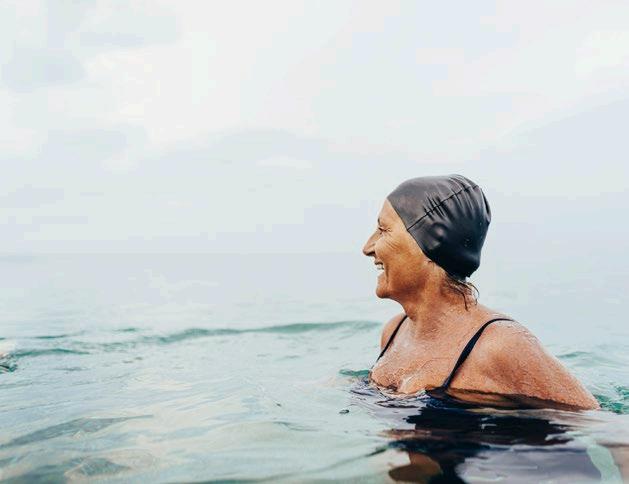
Otherwise, come on in—the water’s lovely!
Psychiatrist Dr Chetna Kang is chair of the mental health advisory board for Doctorpedia, the world's largest network of medical websites.
How did you become a mental health expert?
I qualified as a medical doctor and did specialist training in psychiatry. With psychiatry I got to spend more time with patients and to know them as an individual. I’ve been working in mental health for 20 years. I love how small changes have a big impact.
What might indicate that someone is in mental distress?
If a particular feeling—elation, worry, sadness—is around for longer than a few weeks, is not alleviated by anything, is more intense and starting to interfere with your quality of life and your functioning, it’s time to talk to someone, even if it’s a friend. A prolonged disruption in appetite or sleep is often an indication something needs to be looked at.
When and where should people seek professional help?
If you or someone you know feels unsafe, there are special phonelines, your mental health trust’s crisis team you can self refer to, and A&E. If it’s a crisis, get help straightaway. Otherwise,

your GP can refer you for counselling, therapy or to a psychiatrist. Don’t shy away from help; the longer people leave it, the more prolonged the recovery.
What tips can you give to boost mental health?
If something is weighing on your mind, write two columns, one listing the things that are uncontrollable and the other—listing what you can influence. Rip off and throw the column of things you can’t control and work through the things you can. Make space between you and your mind with meditation, mindfulness, prayer or a walk in the nature.
What can people do to maintain mental health in the long term?
Get adequate sleep at the optimum time. In the hour before bed, don’t stimulate or agitate your mind. Get adequate nutrition regularly and avoid binge eating or starving. Find the exercise that suits you—whether it’s pilates or circuit training. Develop enduring and nurturing relationships.
For more information, visit drchetnakang.com and doctorpedia.com
Can a stint of mental illness affect your future? Dr Max is confronted by the question this month

Max is a hospital doctor, author and columnist. He currently works full time in mental health for the NHS. His new book, The Marvellous Adventure of Being Human, is out now
“T
he family are really upset and are demanding to speak to a doctor,” said one of the nurses at the end of the phone.
“What’s the problem?” I ask as I cast my eyes down the list of jobs I still have to do.
“They’re worried their daughter won’t be able to become an accountant”. It’s Saturday afternoon and I’m covering the wards of a psychiatric hospital and I’m fairly sure that careers advice isn’t part of my job remit. I begin to protest but the nurse continues.
“Please just come,” she implores. “They won’t listen to me”. I sigh heavily and make my way over to the ward and am met by the young girl’s stricken mother and father. I read through the notes while the nurse makes them a cup of tea. Melissa was in her first year at university. She was a promising student and wanted to become an accountant. Last night, however, police had pulled her out of a river after she jumped from a bridge in a suicide attempt. The
psychiatrist who saw her in A&E felt she should come into hospital for her own safety. She refused. He was worried that she might try and kill herself if she were allowed home, so he arranged a further assessment, the result of which was that she was “sectioned”. This means that, under legislation outlined in the Mental Health Act, someone is detained against their will when it is believed they pose a risk to themselves or others as a result of mental illness and are refusing to come into hospital. It’s not a decision that is taken lightly and two doctors and a social worker have to assess the person and agree that it’s necessary.
Reading through the notes it seemed entirely appropriate —here was a young girl, stressed with exams and depressed after her boyfriend had dumped her, who had narrowly avoided drowning and was still suicidal.
get a job if she’s been sectioned in a psychiatric hospital.” I assured the family that this would not have any long-term impact and that it was against the law to discriminate against people on the grounds of mental illness. Detaining someone under the mental health act is intended to have positive consequences for their life, not negative ones. But of course on one level their anxiety was justified.
Mental illness still attracts considerable stigma and prejudice and even more so in people who have been sectioned. Despite legislation being in place to prevent overt and deliberate discrimination for these people, there is still shame and fear attached to it, especially when someone has been “sectioned”. It conjures up outdated ideas around asylums and One Flew Over The Cuckoo’s Nest.
“Please just take her off the section. We’ll lock her in her bedroom until she gets better,” suggested the dad. It seemed strange that her parents were so preoccupied with the sectioning when the more worrying thing was that their daughter had nearly died. Eventually I began to understand.
“It’s her future I’m worried about,” explained her mum. “She’ll never
The reality is that it is simply a piece of legislation that exists to protect people when they are unwell. It’s an indication of how unwell someone is, not some failure of them as a person. We shouldn’t judge people for needing to be sectioned any more than we would judge someone for needing chemotherapy to treat their cancer. It certainly shouldn’t get in the way of someone pursuing their dreams once they are feeling better. n
Q: Now that I’m retiring, I’m trying to break some old work habits, including my love of coffee. I have only managed to last two days without it so far, before I get a raging headache and have to give up. Why am I finding it so difficult?
- Jacqueline, 68A: I know exactly the difficulties you’re going through as I too have experienced these symptoms when trying to give up coffee. They can be surprisingly tough, can’t they?
To put it simply, the reason you’re experiencing these symptoms is because your body has become very used to caffeine—the stimulant that is in coffee. In fact, caffeine is not just in coffee—it’s in tea, fizzy drinks, energy drinks, and even chocolate and regular consumers trying to give up any of these will experience withdrawal symptoms too.
Caffeine withdrawal symptoms are short-lived but unpleasant. They include headaches, lethargy, low mood, trouble concentrating and irritability. These symptoms tend to come on after one or two days of
abstinence and last from two to nine days. For those who consume a lot of caffeine, it can last slightly longer—up to two weeks. Caffeine isn’t usually considered an addiction and doesn’t cause harm in moderate amounts. It’s recommended though that people don’t consume more than 200mg of caffeine a day—about two coffees. Over 400mg of caffeine should definitely be avoided as this is linked to problems such as heart palpitations and high blood pressure.
To avoid withdrawal, it’s best to reduce intake over a few weeks rather than stopping suddenly. I’d suggest cutting down slowly over a few weeks, rather than going cold turkey. Remember to stay well hydrated as dehydration can make headaches and tiredness worse. It’s worth persevering with cutting down or stopping entirely as those who do, report increased energy, better concentration improved mood and fewer headaches in general.

Got a health question for our doctor? Email it confidentially to askdrmax @readersdigest.co.uk


“I trust Wellman for my health and have relied on it for years”


Veteran BBC foreign correspondent for over 30 years & former independent MP ‘The man in the white suit’, age 82 years


SCIENCE OF HEALTHY AGEINGTM

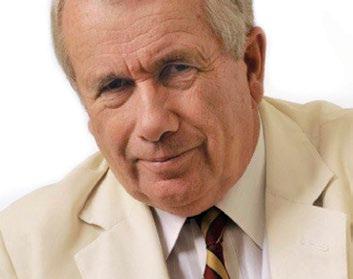

30 nutrients
To help maintain health & vitality
With zinc to help maintain normal vision, immune & cognitive function




LIFE CARE FOR A LIFETIME TM
From , Superdrug, Holland & Barrett, supermarkets, health stores, pharmacies & WELLMAN.CO.UK

*UK’s No.1 men’s supplement brand. †Nielsen GB ScanTrack Total Coverage Value & Unit Retail Sales 52 w/e 30/01/21. To verify contact Vitabiotics Ltd, 1 Apsley Way, London NW2 7HF.


Why do some songs stay in your head for a lifetime? Our memory expert Jonathan Hancock explains
Iwas a BBC radio presenter for many years, including a long stint hosting a record-request show. I soon noticed that almost everyone chose music from the same period: when they were in their teens or early twenties. There are two very good reasons for that.
Firstly, we tend to have a disproportionately good memory between the ages of about ten and 30. Most of us have lots of novel and exciting experiences then, which are always more memorable. And hormonal changes seem to play a part in the vivid memories we lay down as we grow.
The second reason is that music is a powerful trigger for our emotions, which in turn spark our memories. The music of our teen years is likely to have lots of emotions to latch onto, so even a snatch of a particular song can bring powerful feelings and memories flooding back.
There are further ways in which music boosts recall. It can have a calming effect, putting you in a relaxed, safe and creative mood, ready to remember. Rhythms and
rhymes are great memory aids. And when we love a song (or just can’t get it out of our head) we tend to repeat it over and over again, embedding it in our memory. Singing or playing something can even activate “muscle memory”, and there are many cases of people with severe memory loss still being able to perform music they learned decades ago.
So the next time you hear a familiar song, put it to good use, to explore and exercise your memory. Think about the places and people it reminds you of, but also the emotions it evokes. It’s usually by bringing feelings back to mind that you rediscover the richest details.
To remember a particular time in your life, think about the music you listened to then (or even better, play the music again now) and let it take you back, following the connections as you piece together the past.
You can also use music when you’re learning. Find recordings that energise your thinking and focus your mind. If you’re dealing with several topics, play different styles of music while you’re learning different things.
And if you find something particularly tricky to remember, why not play the same song every time you’re working on it—then hum it to yourself later to trigger your recall?
Experiment to see what works for you. Songs can have a powerful impact on memory, and that should be music to everyone’s ears! n
















Researchers are continually finding that certain foods deliver an even bigger health boost when consumed together. Make the most of these nutritious foods by teaming them up
Make your pasta salad with a vinaigrette dressing. Vinegar contains acetic acid, which reduces the spike in blood sugar that occurs after consuming starchy foods high in carbohydrates such as pasta, rice, and bread. A steadier rise in blood sugar reduces hunger by keeping you feeling satiated, as well as helping to minimise the risk of developing type 2 diabetes. Blood-sugar spikes are best avoided, so that your body isn’t secreting too much insulin in an attempt to manage them. Research in 2015 by the Max Planck Institute for Heart and Lung Research in Germany discovered that acetic acid activates the receptors that inhibit insulin secretion.
How about a lunch plate that includes pickled beetroot and sliced hard-boiled eggs? Choline is abundant in egg yolks (as well as in beef liver, chicken liver and veal liver); betaine is found in beetroot, spinach, and some grain products. A 2010 American Journal of Clinical Nutrition study found pairing these two nutrients was associated with lower blood levels of homocysteine, an amino acid produced in the body. Elevated levels of homocysteine
have been linked with declining cognitive function.
This power combination may also protect against cancer, according to a review study by Nanjing Medical University in China in 2016, published in Scientific Reports
Absorb more omega-3
Italian researchers found that adults who consumed a glass of wine a day had higher blood levels of omega-3 fatty acids, which are found in fish such as trout, salmon, herring,
and sardines (the same results were not found for beer or spirits).
The finding is from a 2008 study of 1,604 subjects from Belgium, Italy, and England between ages 25 and 65. Scientists believe that heart-healthy polyphenol antioxidants in wine might be responsible for improved omega-3 absorption.
Omega-3 fatty acids are proven to reduce your risk of experiencing a major cardiac event.
Boost iron intake
Iron is necessary for producing hemoglobin, which transports oxygen to muscles and the brain. Low levels of iron can lead to fatigue, fast heartbeat, headache, and more. Iron from food comes in two forms: heme (found in animal-based foods) and non-heme (found in plant foods such as green beans, edamame, leafy greens, and many others). But our bodies absorb far less non-heme iron than heme iron.
Consume those non-heme iron foods along with vitamin C, which is found in tomatoes, citrus fruit, sweet peppers, berries, etc.
A Swiss study published in the American Journal of Clinical Medicine reported that adding vitamin C to a meal rich in nonheme iron yielded an almost threefold increase in our body’s ability to absorb the iron.
Boost immunity and heart health
Green tea has been shown to strengthen the immune system and, in animal studies, to reduce the growth rate of tumours. And the catechins found in green tea are powerful antioxidants that have a positive effect on cardiovascular health. There’s a way to further
boost the power of those catechins, which are a type of antioxidant: add some citrus juice. According to a Purdue University report, adding a splash of juice from a lemon, lime, or grapefruit to green tea reduces the breakdown of its catechins in our digestive system, making them more readily absorbed by the body.
Try mixing vitamin D-rich canned salmon with calcium-laden plain yogurt instead of mayonnaise the next time you make a salmon sandwich. Vitamin D’s best-known role is to keep bones healthy by increasing our intestines’ ability to absorb calcium. Without enough vitamin D, the body can absorb only up to 15 per cent of dietary calcium, according to Harvard University research. But when vitamin D reserves are normal, we absorb between 30 and 40 per cent of dietary calcium. You can get vitamin D in three ways: through your skin from sunlight; from foods including salmon, tuna, and mackerel; and from a supplement.
Reduce inflammation, body fat
Lab research done back in 2009 in South Korea discovered that genistein (an isoflavone with
antioxidant properties that’s found in soy foods such as edamame and tofu) plus capsaicin (an antioxidant that gives chili peppers and jalapeno peppers their fiery kick) helps tame inflammation. Chronic inflammation in the body is known to be a risk factor for heart disease and cancer. And in 2019, Indian researchers at the Central Food Technological Research Institute found that combining capsaicin with genistein helps increase our body’s ability to digest fat. Spicy tofu stew, anyone?
May help prevent cancer
Adding a little peppery kick to your broccoli with some sliced
radishes can maximise its antioxidant firepower. A 2018 Chinese study published in Food Science and Biotechnology stated that the addition of radish, arugula, and rapeseed sprouts to broccoli sprouts could promote the formation of sulforaphane, broccoli’s signature antioxidant. Foods including radishes possess the enzyme myrosinase, which works to improve the formation of sulforaphane and its absorption rate into the blood. Research suggests that sulforaphane has strong anti-cancer power, particularly by preventing the expansion of cancer cells in the body.
A 2018 study by Appalachian State University in North Carolina, published in the journal PLOS ONE, shows that consuming both water and bananas is just as, or more, effective than a sports drink for exercise recovery. Bananas mimic ibuprofen in reducing pain and inflammation—thanks to boosting serotonin and dopamine levels— while the water rehydrates the body.
Give you more energy
Any dish made with chickpeas is tastier with onions, but the combination is also good for you:
according to a 2010 study in the Journal of Agricultural and Food Chemistry, sulfur compounds in onions, garlic, and leeks can help you absorb more iron and zinc from grains and legumes, including chickpeas. Iron is involved in the transport of oxygen in the body, so an iron deficiency can cause fatigue and “brain fog.” And as for zinc, a large body of research shows it’s effective in fighting the common cold. For example, a 2017 review study by the University of Helsinki in Finland found that the duration of cold symptoms were reduced by one third for those who took zinc. &
If you normally sautée vegetables in butter, consider switching to olive oil. Research from the University of Barcelona, published in Molecules in 2019, showed that when cooking onions, garlic, and tomatoes in olive oil, the oil acts as a vehicle that boosts the bioavailability of the vegetables’ components.
In other words, heating this combination of ingredients, known as “sofrito” in some Mediterranean cooking, was shown to allow more of the vegetables’ polyphenols (which are antioxidants) into circulation in our body.
Rutin is a bioflavonoid, or pigment, that’s found in buckwheat, a whole grain used to make some flours and noodles (it’s also in apple skin, figs, green tea, and more). And vitamin C is, of course, found in many fruits and vegetables, including broccoli, citrus fruit, and tomatoes. A 2019 Polish lab study found that the combined antioxidant and anti-inflammatory action of rutin and vitamin C can protect skin cells from the effects of UV radiation from sunlight. A bowl of soba noodles (a type of Japanese
noodles made with buckwheat) plus vitamin-C-packed vegetables makes a healthy meal.
Poultry, beef, pork, and fish are all top dietary sources of coenzyme Q10 (CoQ10). This power source for our body’s cells plays a vital role in the production of the energy we use for everything from digesting food to running on a treadmill. CoQ10 may also help control blood
Kale, as well as other leafy greens, contains a lot of lutein and zeaxanthin, which are antioxidants that may protect against cataracts and macular degeneration, both leading causes of blindness. These antioxidants are deposited in the retina, where they reduce sunlight damage. You can bolster absorption of them by consuming dark leafy greens with foods containing healthy fats, such as nuts, avocados and olive oil. And, an animal study in 2011 showed that lutein and zeaxanthin may also reduce the effects of “bad” LDL cholesterol, thus decreasing plaque build-up in your arteries and reducing your risk of heart disease. Enjoying kale sauteed in avocado oil or sprinkled with walnuts is a winner.
A stir-fry that includes sliced pork and mangoes is more than just delicious. The beta-carotene in orange-coloured fruits and vegetables (eg, mangoes, carrots, sweet potatoes) is converted into vitamin A in your body. In addition to its role in bone growth, this vitamin is good for maintaining the health of your skin, eyes, and immune system. But you need zinc to get the optimum benefits of vitamin A; it is necessary to make retinol-binding protein that transports vitamin A throughout your body. You’ll find zinc in pork, poultry, beef, lamb, pumpkin seeds, oysters, and wheat germ.
The results of a 2016 randomised, controlled British study, published in Nutrition Research, showed that consuming almonds changed levels of gut bacteria in participants: almond skin and almonds helped healthy bacteria in the gut flourish. Probiotics are found in fermented foods such as yogurt, miso, sauerkraut, kefir, and kimchi. Helping healthy bacteria thrive is important because once they multiply, they can outnumber illness-causing bacteria and bolster immunity. Almond muesli with kefir for breakfast? That’s powerful stuff. n pressure in those with hypertension. A 2010 Japanese study discovered that eating grapefruit allows up to 50 per cent higher cellular absorption of CoQ10. Chicken roasted with sliced grapefruit, onions, and other vegetables makes for a delicious family meal. But beware of eating grapefruit if you are taking certain medications—statins is one example, but talk to your doctor—as it can cause some medications to pass into your bloodstream too quickly, which could be dangerous.























WHATEVER your sleep problems, the dream of a good night’s sleep has now become a reality – thanks to a breakthrough invention - the Gx Suspension Pillow. All conventional pillows atten signi cantly during sleep – becoming less supportive and more uncomfortable as the night progresses. The result of this is disturbed and broken sleep, frustration and the fruitless search for a better pillow. That search is now over!
To stop the attening we’ve come up with a solution that’s so simple it’s ingenious. By the clever installation of ‘double X’ internal ties we have produced the world’s rst pillow to retain much more of its plumped shape all night long.
Harley Street Consultant and back pain specialist, Dr Deane Halfpenny, recommends Gx Pillows:
I can honestly say that your pillow has made the world of difference…and fully endorse your pillow as being quite unique in its ability to maintain support throughout the night
















The ties work to pull the pillow in and up so that your head and neck are gently cradled and supported in softly sprung comfort. As well as having the revolutionary internal ties, the pillow shell is 100% cotton with our superb hypoallergenic Polycoz lling, and we have added a unique integral air vent to help keep you cool through the night.
As if all these bene ts were not enough, you can purchase the pillow with our 30-night comfort guarantee – total satisfaction or your money back*.
Tens of thousands of delighted customers have already rediscovered the bene ts of a great night’s sleep, why not join them? Now available with 20% o for Reader’s Digest readers, use code RD6.
Actor Rula Lenska had this to say:
It is rare that something advertised as unique and life changing turns out to be true!! I have a chronic back and neck situation and I can honestly say these pillows make a huge difference!! Comfortable…supportive…and positively magical for my neck!! Congratulations! Many, many thanks






























































































“The music is in the air. Take as much as you want"
- Worcester resident, Edward Elgar
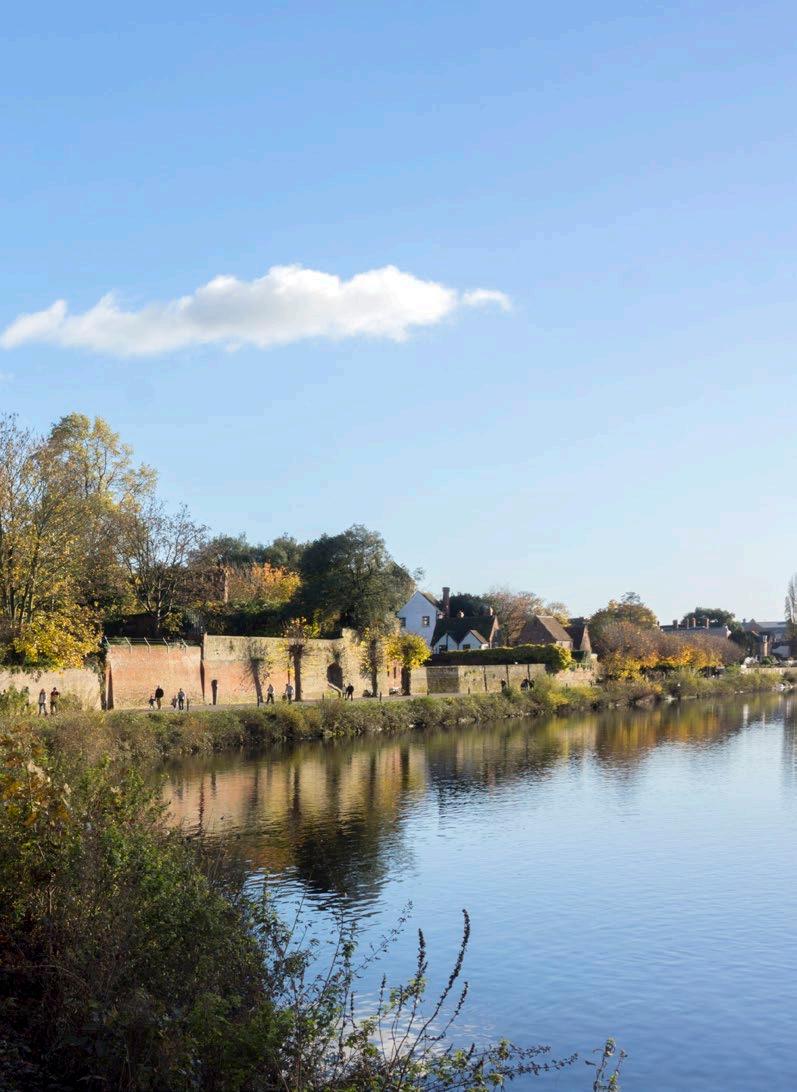
One of the oldest cities in England, there is evidence of settlements in Worcester dating back to 700BC, and historical influences can still be felt in every corner of the city, from cobbled Tudor streets to Roman paths and remains of the Medieval city wall.
Visitors can take in some of this abundant history by visiting the magnificent Worcester Cathedral, which rises out of the city landscape alongside Britain's longest river, the Severn. There's also industrial history to be discovered at the Museum of Royal Worcester, the immersive Tudor House Museum and the elegant Worcester City Art Gallery. If history isn't your bag, there's still plenty to enjoy, with a host of independent restaurants, shops and bars, live music venues, festivals and sporting arenas aplenty.
Along with his wife Helen, Worcesternative Paul Harding is the owner of Discover History (discover-history. co.uk), which works to make the rich history of the UK exciting and accessible to everybody

I have lived in Worcester all my life and after starting to research my family tree, several years ago, I seem to have ancestors living in Worcester as far back as the early 1800s. It sounds a cliché but I feel at home in Worcester, despite working across Britain with my wife Helen through our business "Discover History". Seeing our Medieval cathedral and the Malvern Hills beyond makes me smile. I believe everyone has a spiritual home, and Worcester is mine.
Worcester is a very ancient city, but has a modern outlook. A city that has seen all the great chapters in British
history, Worcester can boast settlements as far back as 700BC. Despite being called a city, its size is perfect and it has everything you need to live a safe and happy life. The city sits on the banks of the River Severn and is nestled in some of the best countryside Britain has to offer.
Worcester has seen everything. From Viking raids, King John, Sir Edward Elgar, fine bone china… the list goes on and on. However, if I had to choose, my favourite part of the city's history would probably be the English Civil Wars. Worcester is often referred to as the "Faithful City". However, the evidence


would seem to show an "Unfaithful City", which is a more interesting story to be honest. Worcester saw the first and last battles of the Civil Wars (Powick Bridge 1642 and Worcester 1651) and has used this title ever since the Restoration. However, the city merchants sided with Parliament in 1642, including well known families such as the Wyldes and the Nashes.
At the Battle of Worcester, the citizens fought Royalists outside the Medieval walls and even fired at King Charles II, before joining the Parliament Army to liberate their city. To hide all this disloyalty we like to use the strap line— "Worcester, the Faithful City".
Discover History was founded in 2003 to bring history to life for people of all ages and abilities. We deliver talks, award-winning school workshops, care home reminiscence sessions, living
history for the heritage industry, film, TV and radio work. However, the most rewarding has to be conducting guided tours of the city I love. We started with one 90-minute tour called the "Worcester Story". This has now become one of 35! It's surprising how many local people go on the tours too. They love to learn about the old pubs, the spooky goings on and how the city has changed over the many years.
My favourite place in Worcester has to be the quiet and peaceful grounds of the Medieval cathedral.
You can sit on the grass in the summer and hear the Peregrines swooping through the sky, the hum of a narrow boat travelling past the swans on the river and the ancient chimes from the cathedral bell tower.
It is my favourite spot in a pictureperfect city.
Claire Bishop is the owner of the Worcester home and gift store Cornucopia, which was named Britain's Best Small Shop in 2020
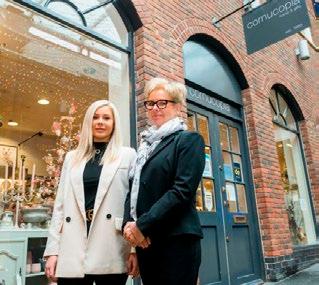
I've always loved Worcester, and when I first moved to the area 31 years ago, I was instantly drawn. I felt that Worcester had a lot to offer with lots of independent shops, restaurants and coffee spots, which were all quite individual. The larger high street stores were represented too and all were accessible, particularly with a growing family. And all this, alongside a magnificent cathedral, situated on the banks overlooking the beautiful River Severn… what isn’t to love?
Worcester is centrally located and easy to reach from anywhere in the country. And, of course, we must not forget the famous Worcestershire Sauce
which has put our city of Worcester on the global map.
My home and gifts store, Cornucopia, has gone from strength to strength. In the autumn of 2019, my eldest daughter Hannah joined me full time to help run the shop after acquiring a degree in interior design.
We are extremely fortunate to be able to offer customers exclusivity with some beautiful products. After a year of uncertainty which actually gave us the impetus to set up our own web shop (cornucopia-worcester.co.uk) and launch an online boutique on Trouva, we are excited to be reopening our doors in Worcester city centre on April 12. We're so grateful for the support from the government which has helped assist our shop and staff throughout lockdown and hopefully remain a bricks and mortar shop within the city for many years to come.
To be voted as Britain’s best small shop 2020 was humbling, amazing and such a surprise… it gave us just the boost we needed!
Worcester has all of the benefits of a big city and a great community spirit, but the safety of a smaller town. It’s vibrant, welcoming and steeped in history. There is so much to discover while visiting… there is far too much to do in one day! n
To plan a future visit to Worcester, head to visitworcester.co.uk
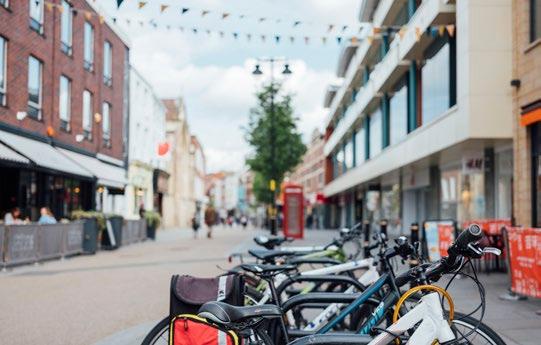




Artist and author of the PEN/Faulkner Award finalist, Extraordinary People, Paul Gervais’ latest exhibition is a series of portraits inspired by Lucian Freud
I would be a king, not a prince. I used to want to be a prince. Mostly because I wanted to wear the clothes, whatever the era or culture: Renaissance, Ancient Egypt, Maasai warrior… My mother killed me with childhood dentistry and I appreciate that now that I’m old, but regrettably this shower of affection did not make me a prince. Never mind, the prince thing is no longer my goal. I want to be king. That’s the ticket. And if so…
I would outlaw couples sitting side by side, facing out in a restaurant. This might be OK for them, a nice alternative to looking only at each other throughout the meal, but I don’t see why I should have to be the object of their attention with all the whispered comments and giggles. Sure, I’m paranoid, but so?
All human beings would have a roof over their heads. I don’t understand
those who seem to feel that if this were the case their own roofs would suddenly leak like a shower head…
People would be arrested for falsely claiming their pets are “service dogs”. In the market the other day a woman was asked to remove her dog and she said, “This is a service animal.” The market employee backed down. I knew she was lying. It was a dropkick yorkie or something. A little while later I saw her out on the street carrying the dog, not the other way around.
The “cult of personality”, which has been so dangerous in the case of our former president, Donald Trump, would be allowed to apply only to me…
Churches would have strict dress codes. The church I head would disallow leggings, sports bras, baseball hats and take-out coffee at
mass. If you’re going to dress like that, then attend your services virtually, with the video off.
I would institute a new, albeit radical ruling: children would be required to respect their elders, and not to answer back.
Clean, fresh water would be a human right. And while we’re on the subject, only if we’re experiencing a life-threatening drought should we be allowed to consume bottled mineral water imported from thousands of miles away.

Self-Portrait, by Paul Gervais. Courtesy of the Boca Raton Museum of Art and the artist
I would right wrongs. There are essentially two kinds of people in the world, the bullies and the bullied. All the worldly goods of the bullies, I would decree, are to be repossessed, divided up and distributed among the bullied, and I don’t care if the bullied were already far richer than the bullies to begin with.
All nudity would be forbidden. It’s unnatural.
If I was truly the absolute ruler, then I would require that everybody loved me, but not the way they loved Gaddafi, ie, to death.
I’d inject kindness. I would ask Astra Zenica, Pfitzer and Sputnik to
develop a “Kindness Jab” with which to inoculate the entire world’s population. Anti-kindness-vaxers would all be sent to hate camps until they could come to their senses, after which we would all treat them with loving kindness and eternal forgiveness.
The distinguishing feature of my rule would be this: love gone viral. n
The exhibition, Paul Gervais: Faces and Forms is on view at the Boca Raton Museum of Art, Florida, through May 30.
Watch “A Conversation with Paul Gervais” on the Boca Raton Museum of Art
YouTube channel for a virtual tour of the exhibition with the artist himself

Lynne Wallis looks at the fascinating tradition behind grieving our beloved pets and its evolution since the Victorian era


"Wee Bobbit," begins the touching inscription on the headstone of a small Victorian London grave. "In memory of our darling little Bobbit… so lonely without our darling sweetheart." The Dickensiansounding Bobbit was born in 1885 and passed away just six years later. A child who had perhaps tragically succumbed to diptheria or measles? Bobbit was in fact a family dog whose owners believed—as so many Victorians did—in an afterlife, not just for themselves but for their pet pooches too. This loving family were convinced they would see their
“THE VICTORIANS GRIEVED THEIR PETS AS THEY WOULD ANY OTHER FAMILY MEMBER”
beloved Bobbit again. The inscription ends on a longing note, "When our lonely lives are over, and our spirits from this earth shall roam, we hope he’ll be there waiting, to give us a welcome home."
New research from Newcastle University on the changing nature of
our relationships with our pets from the Victorian era onwards shows they began to be regarded as family members around the same time the UK’s first pet cemetery opened in 1881 in London’s Hyde Park. The role of both cats and dogs had already shifted far beyond fulfilling a functional working role—with cats "employed" for pest control and dogs mainly for security—to meeting an emotional need.
Upper class Victorian households were the first to embrace their pets as part of the family, according to historical archaeologist Dr Eric Tourigny, the author of the new research. Entitled "Do All Dogs Go to Heaven?", the study tracks human-animal relationships through the archaeological survey of pet cemeteries and explores not just the changing relationship between humans and their animals, but the Victorian belief that pets, like their owners, had an afterlife.
“Only very affluent families could afford to have their dogs cremated and buried with elaborate headstones” says Tourigny. “The very first pet cemeteries would have the initials of the person who wrote the inscription in the bottom right hand corner. A little later, as those grieving the loss of a pet became more comfortable with expressing their emotions. You can see 'mummy' or 'daddy' written there, and the dog will even have the family name, for
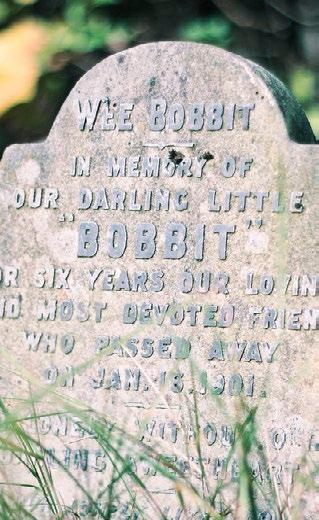
example, 'Spot Smith.' The Victorians grieved their pets as they would any other family member.”
The trend for the belief in an afterlife for animals didn’t always sit well with some in the religious community, with household pets being given human burial rights occasionally causing uproar. During the 1880s, an Edinburgh woman organised a full funeral procession and cemetery burial for her cat, and the crowd that gathered were so upset they dug up the deceased feline and smashed its grave. More secular inscriptions
Headstone in a pet cemetery and pet burial ground in Jesmond Dene in the City of Newcastle
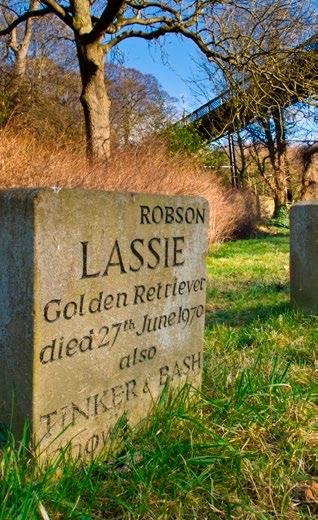
gained popularity as pet owners started to exercise caution about what they wrote on the headstone.
Burial in a pet cemetery isn’t and never was the exclusive preserve of cats and dogs—Dr Tourigny found a budgie’s headstone in London and a tortoise in Newcastle. “You don’t always know the species,” he explained. “Names such as Pussy and Fido make it easy, but other pets were part of the family too. There is a rumour of monkeys buried in the Hyde Park Cemetery.” Only around one per cent of all pets ended up in the cemeteries, as most grieving pet
owners couldn’t afford the hefty fees.
Hyde Park’s first burial followed the death of an adored Maltese dog called Cherry whose owner used to walk her there daily, and who asked the park’s gatekeeper, a Mr Winbridge, if his dog could be buried in his personal garden. Until then, pet cemeteries were only popular in Germany. The kindly Winbridge agreed and over the next few decades hundreds more dogs joined Cherry. Over 1,000 burials took place before the cemetery became too full to take any more pets in 1976.
The comforting "sleep" metaphor frequently used on human headstones began to be used for pets too in the late Victorian era, and many of the animal graves at Hyde Park include a kerbstone and a headstone, so that they look like a bed. "Rest in Peace" or "Here lies" were, as for humans, common engravings. One double canine grave headstone reads touchingly, "We are only sleeping, Master’."
Most pet owners buried their animals at home, but others sought public expressions of grief and loss, and by 1900 more pet cemeteries opened around Britain. There are now around 20 in operation, according to the Association of Private Pet Cemeteries and Crematoria (APPCC) and an estimated 120 pet crematoria. Ilford pet cemetery opened in 1930 and has 467 pets buried there, while later

“WHEN THE MASTER PASSED AWAY, IT WAS THE ANIMAL'S TIME TO GO TOO, EVEN IF IT WAS FIT AND HEALTHY”
cemeteries such as Northumberland Park in North Shields in the North East buried 210 pets from 1949 to 1988. “Aside from meeting a growing need, I suspect those that set them up realised they could make a few bob,” said Dr Tourigny.
The reference on headstones to
pets as family members increased after the Second World War, with family names on pet gravestones becoming commonlace. Early adopters put the family name in parentheses or quotation marks. Were they acknowledging the pets weren’t full members of the family, or pre-emptively avoiding criticism? Tourigny isn’t sure. What he is certain of is that the Victorian era represents a watershed for human-pet relationships. Many Victorians loved their pets so much they wanted to be buried with them. Some cemeteries allowed it, but it often ended

unhappily for the cat or dog that ended up being euthanised before its time—graves couldn’t be dug up to add an animal’s body, so when the master passed away, it was the animal’s time to go too, even if it was fit and healthy. The trend died down after a few years, but began to reemerge in the UK in the 1990s when pet ownership stared to rise, with the first recorded double pet-human burial in Lancashire in 1995. New Yorkers embraced the idea a little later, and in 2015 the city passed a law allowing pets to be buried alongside their owners.
“PET BURIAL IS STILL AN UNREGULATED INDUSTRY—IT'S A MONEY MAKER FOR BIG CORPORATE OUTFITS”
Ilford Animal Cemetery in East London, which was part of the Newcastle University study, was opened by the PDSDA charity in the 1920s. Some 3,000 burials were carried out until it closed for new burials in the 1960s. It contains many beloved household pets, including
MIRA / ALAMY STOCK PHOTOBruce Forsyth’s dog Rusty, but it's also the final resting place for celebrated military animals that were awarded the Dickin Medal, often referred to as the animals’ Victoria Cross. The medal was given to animals that exhibited "conspicuous gallantry and devotion to duty" during the Second World War and subsequent conflicts. Some 32 pigeons are buried at Ilford, 18 dogs, three horses and a "heroic" ship’s cat called Simon that served on the Second World War's HMS Amethyst.
As was the case when the first pet cemeteries opened all those years ago, it’s still only about one to two per cent of pet owners who bury their animals this way, with around 15 per cent choosing home burial. An estimated 51 per cent of adults have a pet, according to the PDSA, and every year some 1.5m of them die. Kevin Spurgeon is director of the APPCC and runs the Dignity Pet Crematorium in Hook, Hampshire. A passionate advocate of care and compassion around pet death, Spurgeon is happy to accommodate double burials. He says, “We are seeing an increased demand for pets to be buried alongside their owners. We have a couple in our garden who are buried with 13 sets of their pets’ ashes all interred together, and a lady who is buried with her cats. The trouble now is that a lot of pet cremations are carried out by big corporate vet chains, and

there really isn’t any proper care for the pet or its owner.” A pet funeral costs around £660 which includes £50 towards a headstone (they cost approximately £150), attendance by the family, maintenance of the grave, and visiting rights. Spurgeon added, “Pet cremation and burial is still an unregulated industry. It’s just a money maker now for these big corporate outfits, and that’s not how it should be. Pets do so much to help us through this great journey called life, and we have a duty of care to them not just during their lives but after they have gone.” n
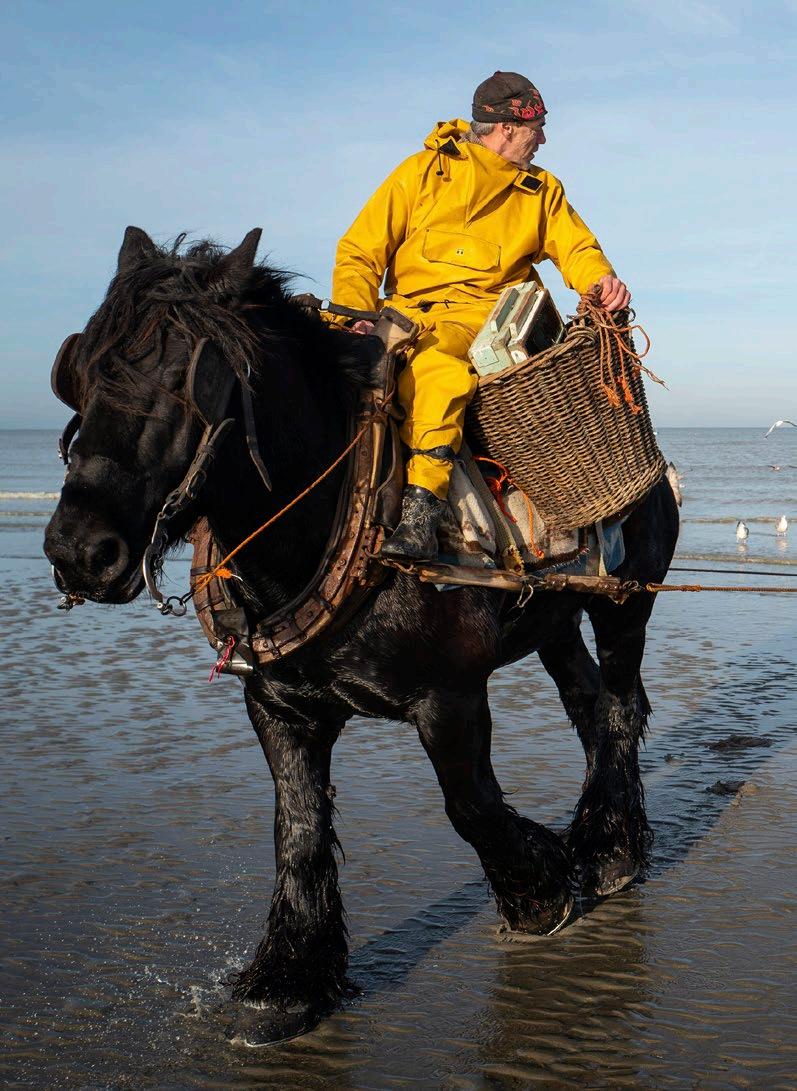
On the Flanders coast, a centuries-old tradition survivesBy
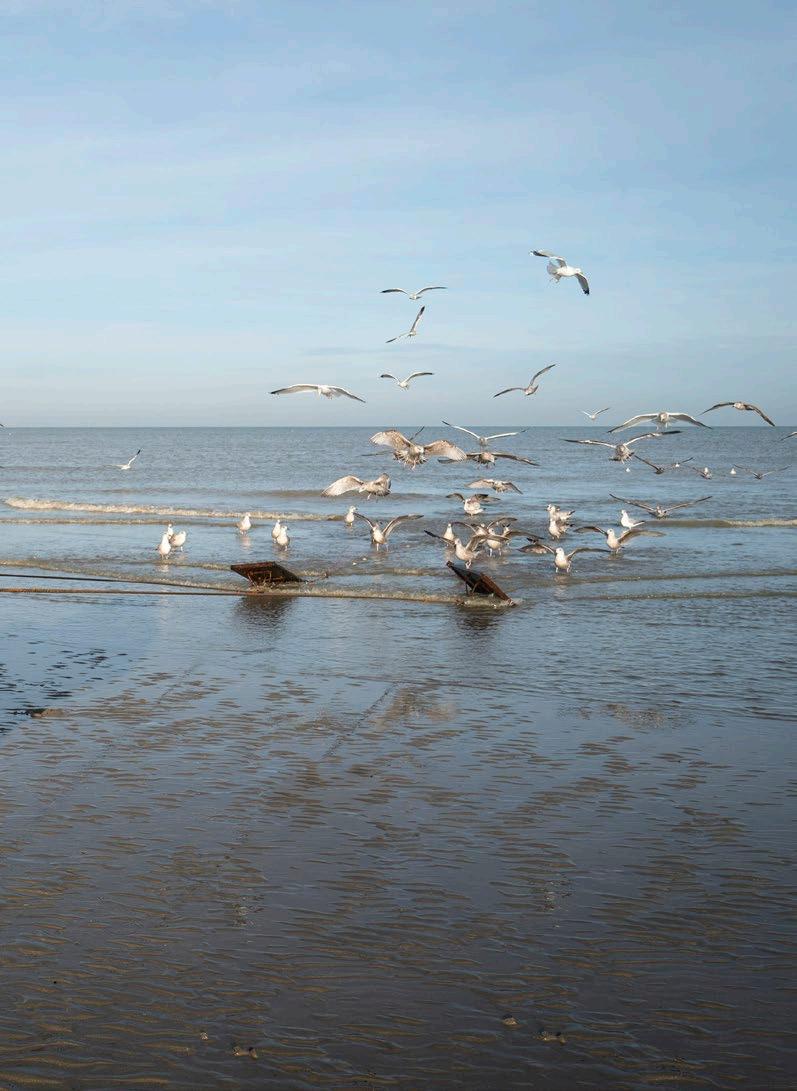 Hofstein
Cyril
from le figaro
photos by Jeremy Lempin/Figarophoto
Hofstein
Cyril
from le figaro
photos by Jeremy Lempin/Figarophoto
G“ood, you are on time. If we miss the tide, we won’t bring back any shrimp.”
Dominique Vanden-driessche, one of the last paardenvissers—Dutch for horse fishermen—in Oostduinkerke, Belgium, is in such a hurry to leave that he definitely would not have waited for us if we had arrived late. It’s still dark. The sandy landscape is pastoral, with pretty, low houses.
“Before the popularity of seaside tourism, people in the region were starving,” explains Dominique.
weighing almost a ton has been going to the sea only for a year, but he is already so used to the task that he could almost put himself in the shafts of his cart. With a kind, soft voice and in a sung language known only to the two of them, Dominique proceeds to guide Jako gently after harnessing him.
In a few minutes, everything is ready. It’s time for us to go. A walk of two miles awaits before we reach the seashore. Here in West Flanders, between De Panne and Nieuwpoort near the French border, the link that has for centuries united horses,
“Nothing was growing properly. We were poor from one generation to the next, and the farmers had to fish for shrimp to make ends meet. Times were hard and so were the men. Sometimes, despite progress, and the madness of our times, I tell myself that nothing has really changed. You still have to fight to earn a living.”
With a steady hand, the young man—he’s 31—brings out Jako, an imposing Brabant, from his stall and prepares to harness him to his cart. In the pungent cold, the horse’s nostrils release two white plumes. At the age of six, this placid and powerful Belgian draft horse
men, and the North Sea has never been broken.
Almost every day from April to November, the last of the horseback fishermen set out at low tide in search of great shoals of shrimp, the “white gold” of Flanders. This tradition, unique in the world, has been going on for more than 500 years. Before the Second World War, this method of fishing was practised throughout the region—in Belgium, northern France, the Netherlands, and southern England. But it has gradually fallen into oblivion, except here in Oostduinkerke, where since 2013 it has been listed

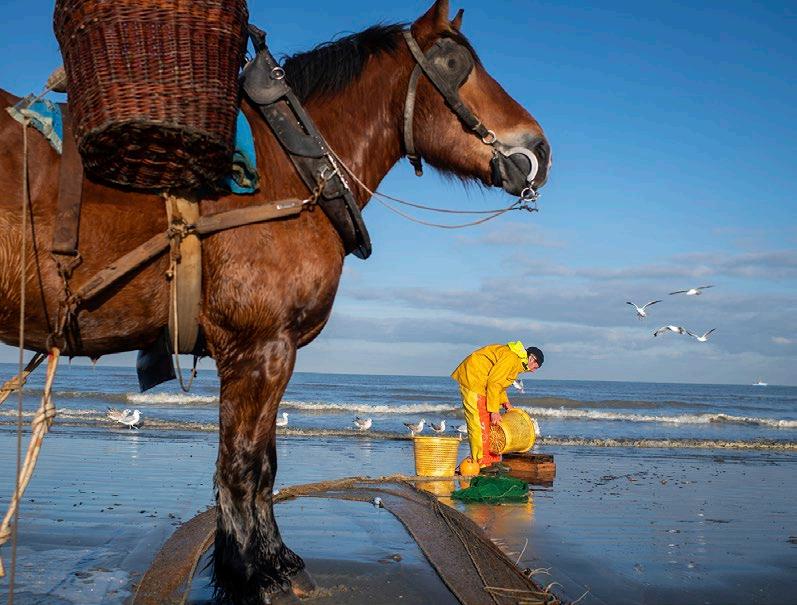 Above: The streets of Oostduinkerke, West Flanders, where the link that has for centuries united horses, men, and the North Sea has never been broken; Below: The catch is sorted so that the smallest shrimp are returned to the water to keep growing
Above: The streets of Oostduinkerke, West Flanders, where the link that has for centuries united horses, men, and the North Sea has never been broken; Below: The catch is sorted so that the smallest shrimp are returned to the water to keep growing
as a Unesco Intangible Cultural Heritage of Humanity. Among the 20 or so horseback fishermen that the town still has, Dominique Vandendriessche is undoubtedly one of the most dedicated; alone or with his friend Katrien, he heads to the shoreline three or four times a week.
To reach the high dunes and the beach that stretches as far as the eye can see, Dominique’s route is always the same: he crosses the streets of the very chic residential seaside resort area of Koksijde, then heads toward the main boulevard.
gather. “They are always waiting for us,” Dominique says with a laugh. “These birds know that they will soon be able to pounce on the small fish, crabs, and shrimp that will escape our net. It’s been this way for years. Nothing is ever wasted.”
Jako is now uncoupled from the cart and the fisherman, who has just adjusted his yellow raincoat, and attached the cables of a long funnelshaped trawl net to Jako’s sides; it’s held open by two wooden panels with iron rings. About 98 feet long, the net is equipped with a chain, the
Residents often open their windows to greet the passage of the cart loaded with fishing equipment (here in Oostduinkerke, paardenvissers are so famous that statues in their image have been erected on the promenade along the shore to honour them).
Even the tram, which normally has the right-of-way, stops to let him pass. And motorists rarely lose their patience behind Jako, whose enormous, shod hooves squeak with every step on the pavement.
At low tide, the North Sea is nothing more than a thin slatecoloured line on the sand. As we approach the water, dozens of gulls
end of which drags along the sand, creating vibrations that compel the crustaceans to jump inside. Then he attaches a wicker basket on either side, straddles his horse, and gently directs him into the waves. Fishing has begun.
Dominique first advances in a direction perpendicular to the beach before turning to move along the coast. Every half hour or so, the fishing stops and he returns to shore before the net becomes too heavy to pull. This is also an opportunity for Jako to take a breather.
Amid the shouting and bickering of the gulls, and with onlookers gathering, the fisherman opens

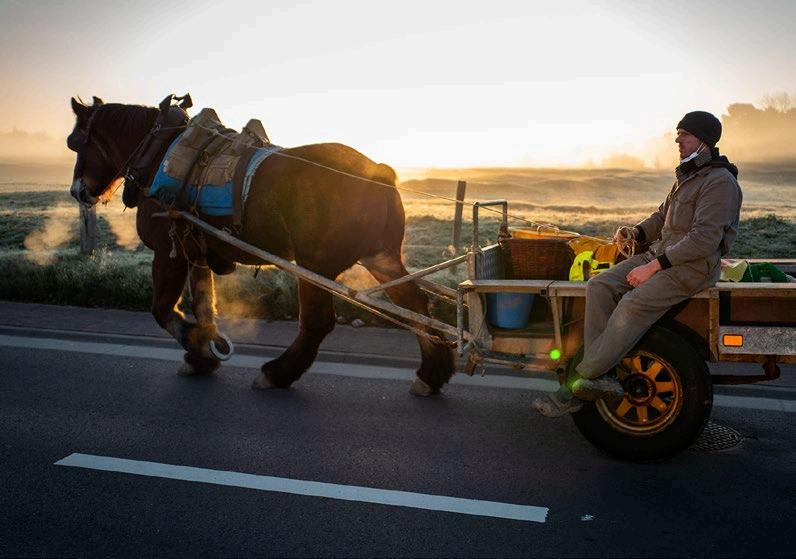 Above: Shrimp fishermen stay in shallow waters near the shore, pulling a funnelshaped net behind them; Below: A few times a week, Dominique Vandendriessche heads to the shore to fish with Jako, his powerful but placid Belgian draft horse
Above: Shrimp fishermen stay in shallow waters near the shore, pulling a funnelshaped net behind them; Below: A few times a week, Dominique Vandendriessche heads to the shore to fish with Jako, his powerful but placid Belgian draft horse
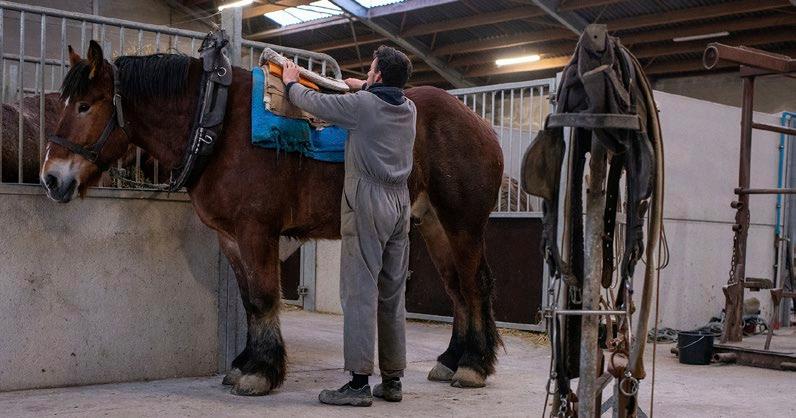
From top: Dominique tends to six-year-old Jako, who has been on the job for just a year; freshcooked shrimp; Dominique prepares his catch. These shrimp will be turned into tasty specialties such as croquettes and bisques that will be served at his small takeway restaurant



the end of the trawl and pours his harvest into a sieve to make a first sorting. It’s almost all shrimp. While the smallest ones slip through the mesh and drop back into the shallow water, the future is darker for the small crabs and fish, which Dominique tosses aside: almost none escape the gluttony of seabirds.
It is when the water is coldest that shrimp are most abundant, and this morning, Dominique is not displeased to have got up so early. The tide will come back in a few hours, and he will repeat the same manoeuvre before returning home to sort his catch and put Jako in the meadow for the rest of the day.
After being washed, the shellfish will be cooked in a salted-water broth for about ten minutes, then spread out on a rack and drained before being shelled by hand and then sold.
“I’m 31 years old and I’ve lived like this since I was a child,” says Dominique. “I started at a very young age with my father, who taught me everything. But more than the shrimp, it’s the horse that fascinates me. The horse and the work you can do with it.” He says that it is no longer possible, especially for a couple, to make a living from this work only: “On average, we bring back seven kilos of shrimp per fishing day, which
we sell for 12 euros per kilo. It’s a set price that we horseback fishermen have agreed on in order to avoid the supply-anddemand scenario of the boat fishermen. But it’s not enough. The boat fishermen bring back much larger quantities every day, and can often sell their shrimp for much more than we do.”
To continue to make a living from his passion, Dominique went into debt to open his own farm-totable takeaway restaurant, called Het Trekpaard, where you can taste specialties such as shrimp croquettes, bisques, or cassolettes. He also started a stable dedicated to Belgian draft horses and an equestrian educational centre that offers horse-drawn carriage rides.
It’s a godsend for the city of Oostduinkerke, which organises an annual shrimp festival with the participation of the Royal Order of Horse Fisherman (or Koninklijke Orde van de Paardenvisser); it normally takes place on the last weekend in June. Created in 1967, the Royal Order conducts research on the practice of horseback fishing and raises public awareness of the tradition. Because nobody here can imagine that the horseback fishermen of Oostduinkerke may one day disappear. n
From Le Figaro (November 13, 2020) Copyright © 2020 by Le Figaro
Look beneath the surface of Delhi’s never-ending chaos and you will find treasures both great and small
By Priya Krishna From HemispHeres magazine F or United a irlines The Tomb of Isa Khan at Humayun’s Tomb complex in Delhi
The Tomb of Isa Khan at Humayun’s Tomb complex in Delhi
India’s capital city is often described as “organised chaos,” a concept that applies to every aspect of Delhi: the crowded streets, the boutiques and art galleries coexisting with centuries-old ruins, the fruit and tea vendors traversing the city with their wares.
In recent years, however, the city has undergone a transformation. Interwoven among the stately buildings, relics and beloved food stalls are new restaurants, markets, and developments that lean into India’s bountiful heritage. Instead of gazing outward, Delhi, it seems, is finally looking inward.
I’ve been visiting this city since I was a child. Indian culture normally dictates that I stay at my aunt’s place, so it’ll take some time to adjust to my spacious room at the The Oberoi, in the New Delhi district of Delhi. I’m excited to explore the city on my own for the first time.
On my first day I decide to dive headfirst into Old Delhi, so named because it was a former capital of the Mughal Empire. It is 1,500 acres of sensory overload: rickshaw horns blaring, frying pooris giving off their nutty scent, and throngs of people weaving through narrow alleys and bustling streets. After breakfast I set off with Vishnu, a ToursByLocals guide. Along the way, we pass the Red Fort, whose moat-lined stone
wall separated the palace complex from the rest of the city during Mughal times. I know we’ve reached our destination when we begin to share the road with cows and sugarcane juice vendors.
Our first stop is the Jama Masjid mosque, which was completed in 1656. I can’t help but compare the breathtaking structure—soaring red sandstone minarets, white marble domes, lines from the Quran carved in black onyx—to the Taj Mahal. Both were commissioned by Emperor Shah Jahan.
From there, we take a brisk walk into the Chandni Chowk markets where people are hawking everything from silver jewellery to gulab jamun (sugar syrup-dipped milk dumplings). I want to browse, but Vishnu is on a mission to show me the havelis, centuries-old townhouses with elaborately decorated doors. I see one etched with incredibly detailed roses, another that’s bright blue and outlined with mint-green vines.
Chandni Chowk has a lot of alleyways (galis, in Hindi). I have my stomach set on Paranthe Wali Gali, home to a cluster of stands that sell only stuffed breads called parathas. Vishnu directs me to a simple setup with just a few tables that dates back to 1872.
I order two parathas stuffed with paneer, a mild Indian cheese. A cook rolls out the dough, folds in crumbled paneer dotted with fenugreek and


 Clockwise from top left: some of the distinctively carved sandstone of Red Fort; the fragrant bounty of the Chandni Chowk spice market; the Mina Bazaar in front of the Jama Masjid mosque
Clockwise from top left: some of the distinctively carved sandstone of Red Fort; the fragrant bounty of the Chandni Chowk spice market; the Mina Bazaar in front of the Jama Masjid mosque


coriander, rolls it out again, and slides it into a pan filled with ghee. It’s served alongside sabzis (stewed vegetables). I dip a piece into a pumpkin sabzi. It’s a rich, crisp, spicy, and slightly sweet mess.
Back on the crowded streets, Vishnu advises me to “walk like an Indian.” As he charges confidently into traffic, rickshaws magically get out of the way. I try my best to mimic him, but I can’t help but flinch at oncoming cows.
On Khari Baoli, one of the district’s most bustling streets, we browse a spice market with fragrant bags of cardamom pods and saffron threads. I pick up a vial of saffron perfume at a 100-year-old perfumery.
After all that walking, I’m hungry again. I’ve been told that Karim’s kebab house in Chandni Chowk has the city’s finest grilled meats. It was
started more than 100 years ago by the son of a chef who had worked in the court of the Mughal emperor. The seekh kebabs’ beef is so tender it falls off the skewer.
After lunch, I spy a group of plumbers, electricians, and carpenters napping in the shade, awaiting customers. “It’s a good system,” Vishnu insists. “If you need a plumber, you know exactly where to find one.” I’m reminded that I could use a nap too. Back to the hotel.
When I wake up, it’s time for dinner at Indian Accent. The famed tasting menu restaurant is a far cry from Old Delhi—the dining room is spacious, serene, and dimly lit. A parade of dishes appears: pepper crab topped with idiyappam (rice noodles); pork ribs laced with rum and mango pickle; and for dessert, makhan malai, impossibly light
saffron cream topped with rosepetal brittle and almonds. “The idea is to do pan-Indian regional food, but make it new,” explains Manish Mehrotra, corporate chef at Indian Accent Restaurants.
Belly full, I crawl into bed. I’m already looking forward to everything I’ll eat tomorrow.
After breakfast, my driver takes me to Red Fort, the Mughal emperor’s primary residence. Considered by many to be Delhi’s most important monument, it’s surrounded by a mile and a half of imposing red sandstone walls, with ornately carved domes and tall watchtowers. Inside, I explore Rang Mahal, which was home to the emperor’s wives, and Diwan-i-Khas, where the emperor, seated on his bejewelled Peacock Throne, met with courtiers and visitors.
Next is Humayun’s Tomb, which was built in the 16th century to honour Emperor Humayun. With its triptych-style facade capped by an imposing dome, the tomb served as inspiration for the Taj Mahal. Complicated marble inlay patterns line the facade to the 154-foot-tall structure. Delhi is full of public parks, and I’m off to see the most famous one: Lodi Garden, which is both a garden and a tomb for the rulers of the 15th- and 16th-century Sayyid and Lodi dynasties. By the time I arrive, it’s well over 35 degrees.
That doesn’t stop me from being amazed by its design. The tomb of the ruler Muhammad Shah, for example, is octagonal, and the dome is topped with a lotus flower.
Around me, I see couples cuddling on benches and elderly aunties out for a stroll. I’m melting, though. Time for indoor activities.
I meet my aunt Manisha, who has lived her whole life in Delhi, at Café Lota. Warm, bubbly, and open to eating anything, she is the perfect dining companion. The café, housed in the National Crafts Museum, serves regional food showcasing the country’s range of heritage lentils and grains. There’s corn dhokla, savoury fermented cakes from Gujarat adorned with crisped curry leaves, mustard seeds, and a fiery tomato chutney; cheela, a tangy pancake studded with chilies, paneer, cilantro, and green beans; and bhatt ki churkani, a stew of a local variety of black bean.
The flavours are wildly vibrant. I want to order more, but Manisha cuts me off. “We can barely fit what we have on the table,” she points out.
We digest our meals with a spin through the museum, where I find an early-20th-century purple sari embroidered with hunting scenes in gold thread. I’m also enamoured of two hamsa (swan masks) from West Bengal, used in classical dance.
Manisha wants to check out an exhibit at the National Museum
The Lotus Temple is one of Delhi's newer wonders

called Jewels of India showing 173 gems and items of jewellery from the collection of the nazims (monarchs) of Hyderabad. I’m dazzled by the 184.75-carat Jacob diamond and a pearl necklace called a satlarah.
My dinner reservation is at NicoCaara, located in the Chanakya, an upscale mall in Chanakyapuri. The restaurant, a collaboration with the chic Delhi clothing brand Nicobar, is stylish, with botanical wallpaper and plants in gold pots hanging from the ceiling. Co-founder Ambika Seth is one of only a few restaurateurs in India focusing on local sourcing.
“We have a colonial hangover based on this strange complex that imported was always better,” Seth tells me over a plate of nutty zarai cheese, made in Uttarakhand, near the Himalayas. “That’s changing with my generation.”
The rest of the meal is a pageant of bold flavors—orecchiette with fresh
pesto made using basil grown at Seth’s organic farm, and a coconutty prawn stew from Malabar laced with rice noodles, lentils, and earthy mustard seeds. For dessert: a fluffy almond-orange cake with a dollop of not-too-sweet cream. After dinner, I check into Bungalow 99 in the Defence Colony neighbourhood. I barely have time to look around before my head hits the pillow.
The next morning I visit the market at Bikaner House, a former palace that has been converted into an art gallery and cultural space. Every Sunday, vendors sell everything from fresh dosas to artisanal granola. I have my eye on The Pickle Studio, which specialises in achaar, or Indian pickles. I buy a pungent dry garlic version—whole cloves in chili powder and ghee.
From there, I’m off to one last architectural marvel: the Lotus Temple, a Baha’i house of worship. Finished in 1986, it draws more than 4 million visitors a year. The flowering lotus shape, which reminds me of the Sydney Opera House, was chosen because it’s a symbol of purity and peace. Crowds of sari-clad elderly women stream by, elbowing me out of the way so they can take selfies against the backdrop of the temple.
For lunch, I am told that one of the best restaurants in town is Little Saigon in upscale Hauz Khas.
In recent years, Delhi has become notorious for its poor air quality. The smog is worst between October and December, and it isn’t unusual for it to hit 500—considered “hazardous”—or more on the Air Quality Index. Low visibility due to smog sometimes even affects local airport operations.
The good news is that Delhi’s authorities have made some significant changes to turn the tide: ending the use of coal-fired power plants in the city; promoting cleaner-burning natural gas in public transport vehicles; and effectively limiting the use of cars to every other day.
—The EditorsVietnamese food in India? I’m surprised. “I wanted Indian people to know Vietnamese food the same way they know Thai or Chinese,” says chef Hana Ho, a Ho Chi Minh City native who came to Delhi in 2010 to cook at the Blue Ginger restaurant in the Taj Palace hotel before opening Little Saigon. I enjoy a round of summer rolls, followed by a cold noodle salad with homemade pork patties dappled with herbs and fish sauce.
For dessert, I stop at Evergreen Sweet House, a place I’ve been frequenting since I was a kid. The store is a Willy Wonka factory of
activity and colour. I’m here for the kaju ki barfi, diamonds of cashew, milk, and sugar. They’re soft, creamy, and not too sweet.
Now, time for a little shopping. I head for nearby Kamayani, which offers the full range of Indian saris, from the tie-dyed bandhani saris of Gujarat to the striped leheriya style of Rajasthan. The store’s eponymous owner buys textiles from Indian artisans who have spent their lives mastering classic sari-making traditions.
“These saris are works of art and treasures of our country,” she says. I’m tempted to try one on, but I don’t trust my clumsy sari-tying skills with the delicate fabric.
For dinner, I try something new at Mizo Diner, which is devoted to the food of Mizoram in northeastern India. The cuisine is heavy on rice, pork, and bamboo shoots. I enjoy vawska rep, a smoked pork stew with leafy greens, and sawhchiar, a chicken and rice porridge served with an addictive sweet-spicy onion jam.
By the time dinner wraps up, the city is showing no sign of slowing. Car horns honk furiously, and vendors try to sell me the last of their fruit. Even at 11pm, the air is hot and thick.
I go to bed dreaming of smoky pork and saris the colour of cotton candy and all the things I’ve discovered in a city I thought I knew—and where I’ve still barely scratched the surface. n From
eres,No need to fly: our reader Brian Conduit found inspiration close to home…
Ihad to pinch myself. Had I suddenly been transported to a sophisticated continental city? The sight before me looked for all the world like a handsome plaza in Madrid, but I was in fact in the former cloth manufacturing town of Halifax in West Yorkshire. I was looking at Piece Hall, one of the most astonishing buildings in England. Piece Hall came into existence through the wool industry. It was a market hall where local cloth manufacturers would display and sell their goods: “pieces” of woollen cloth. A piece was a 30-yard length of woven cloth. The building was designed by a local man, Thomas Bradley, and was built in the remarkably short time of four years. The official opening day was on New Years’ Day 1779 and the event was marked by large crowds, a procession of local tradespeople, music and a spectacular fireworks display.


Strangely for such a large and prestigious building whose main function was a cloth market, it only operated as such for two hours a week, between 10am and 12 noon on a Saturday morning, and it closed at 4pm on Saturday afternoon. But of course it was built as much as anything to reflect the prosperity and ambition of the cloth manufacturers



and the importance of the woollen industry throughout Yorkshire at the time. Impressive though it is, Piece Hall was not a great commercial success and had a comparatively short life. The growth of great factories in the 19th century made it redundant as traders started to do business directly with the leading woollen manufacturers.
After its closure, it was taken over by Halifax council and had a variety of uses including a venue for concerts and meetings and as a general wholesale market. It was also nearly demolished by the council in the 1970s to make way for a modern development but saved in the nick of time. To have reduced such a fine and unique building to a pile of rubble, the fate of other similar cloth halls in Leeds and Huddersfield, would have been a tragedy.
Today Piece Hall stands as a proud testament to the vital place of wool in the economy of 18th-century Yorkshire. It has been beautifully restored and looks resplendent since its recent face lift in 2017. It survives as a distinctive and fascinating visitor attraction and I was lucky enough to squeeze in a visit in early March 2020, just a few days before the start of the first lockdown. When conditions return to some sort of normality, it is definitely worth a visit. n
Tell us about your favourite holiday (send a photo too) and if we print it, we’ll pay £50. Email excerpts@readersdigest.co.uk

Suspended bridges are bouncy, fun and forever associated with Indiana Jones and the Temple of Doom. You’ll find examples (none of which have been halved by Indy) all around the world— including, rather unexpectedly, above the University of British Columbia’s botanical garden.
Namely the Greenheart TreeWalk, whose narrow hanging bridges total 310 metres while connecting a series of platforms. Around 20 metres high, they stretch just below the canopy of century-old cedars and huge Douglas firs. Although you’ll swing from side to side, stabilising devices ensure that walkways never flip over.
The idea is that walkers can appreciate the sights and sounds of coastal temperate rainforest from an immersive, bird’s-eye perspective, and hopefully encounter lesser-spotted flora and fauna in so doing. Guided one-hour tours led by naturalists are also available each day, and cover tree identification, birdwatching and medicinal plants.
Unlike many canopy trails, this one is eco-friendly: in order to not damage their hosts, every cable is hung using an innovative “tree-hugging” system instead of bolts or nails.
Rarely crowded, the TreeWalk operates happily under the radar thanks to its position on the seaside fringes of UBC’s campus, itself well west of Vancouver’s centre. Dating to 1916, the whole garden is amply worth exploring, with separate areas allotted to Asian, alpine, food-producing and medicinal shrubs.
You can normally visit the TreeWalk between April 1 and October 31. Tickets cost from $23 (about £17) per adult, including the optional guided tour; book in advance to be sure of admission. botanicalgarden.ubc.ca/visit/greenheart-treewalk
By Richard Mellor

This month, Andy Webb offers expert practical advice on the tricky subject of credit reports
Adecent credit report isn’t just nice to have, it can save you huge amounts of cash.
The better your credit history, the better deals you’ll be able to access—from lower rates when remortgaging through to more time at 0% when transferring credit card balances.
In fact, your credit report is checked any time you want to borrow money, which includes getting an overdraft, switching energy and if you pay for insurance monthly. And any mistakes or missing data could result in your application getting rejected.
Fortunately, it’s really simple to check your reports, and it won’t cost you a penny. Here’s how to do it, plus a few simple steps you can take to help improve them.
Often you’ll hear these two terms used interchangeably, but they aren’t the same thing. Your credit report is the record of the times you’ve applied for credit, how much you owe and how you’ve paid off previous debts.
This is an important part of what lenders use when considering whether they want you as a customer. But it’s not the only factor. The details you put in your application can make a huge
difference too, and they might already have their own data on you from previous accounts.
Your credit score, on the other hand, isn’t even seen by lenders. Really it’s just a device to help us as consumers get a quick feel for the health of your report. So at a glance we can see if our report is classed as “Poor” or “Excellent” (or other stages in between). And any improvements we make to our credit file should be reflected in the score.
There are actually three different credit reports, each with their own scoring system. It’s worth checking all of them at least once a year.
They’re provided by the main three credit reference agencies: Experian, Equifax and TransUnion. Each will let you check your report directly with them, and you are able to order a free statutory report by post or online.
But you’re better off using a third party online service that provides the same data for free, along with your credit score and regular updates, such as emails each month if your

Andy Webb is a personal finance journalist and runs the award-winning money blog, Be Clever With Your Cash
score changes. They tend to update monthly rather than in real-time, but that’s perfectly good for keeping track.
You can view your Experian report via MoneySavingExpert.com, Equifax via ClearScore.com and TransUnion via CreditKarma.co.uk.
Once you’ve obtained access to your reports, you’ll probably want to see how you can improve them, and the score is a good way to see if you’re making progress. These are my top four ways to do this.
1. Register to vote
If you aren’t on the electoral register, then this should be your priority. This helps lenders verify your identity and your address.
2. Check for mistakes
Is there anything that looks wrong?
It could be an account you thought you'd closed but is still open, an old address, or even links to an expartner. Get them all fixed.
Double check, too, that there aren’t any accounts that have been set up in your name without your knowledge. If that’s the case you’ll need to contact whoever the account is with to get this fraud sorted.
3. Make payments on time every month
Missed payments will be marked as a default on your file, even if it’s just by
FORTUNATELY, IT’S REALLY SIMPLE TO CHECK YOUR REPORTS, AND IT WON’T COST YOU A PENNY
one day. Set up direct debits to pay everything on time.
If you don’t currently have any credit accounts that help demonstrate this you could look at getting a credit building credit card. Spend a small amount on this each month (a regular expense such as groceries works well) and pay it off completely. After a while this will be reflected in your report.
4. Manage your "credit utilisation"
If you’ve got a number of old cards that you don’t ever use, you might think it’s best to close them down. Well it can help. But it could also hurt your score!
Ideally you want to use below 25% of the total credit available to you at any time. So if you have four cards with a total credit of £4,000 and owe £1,000 on them, that’s a credit utilisation of 25%. But if you close three of the cards and have a credit limit of £1,000, you’ve suddenly maxed out to your limit—which looks bad to lenders. n
Q: I’ve had a shaky credit history due to reckless spending in my early years, which has really come back to bite me as I’ve got older. I recently managed to get a phone contract, much to my surprise and delight, but now I want to know if it’s possible to get a credit card. Is it ever doable with a bad credit history?
- Kelly-Anne, 47A: Hi Kelly-Anne, yes, it is absolutely possible. There are even specialist credit cards designed to help people improve their history.
The best way to find out what you could get is to go via a comparison site and look for an “eligibility check”. This will perform a soft credit
search on your credit report and give you an indication of how likely you are to get different cards. Bear in mind a high eligibility score isn’t a guarantee of success unless it says you are “preapproved”.
If very few cards are showing, or if you are rejected when you do apply, don’t assume that’s it.

Look at all the things you can do to improve your score, and after a short while, apply for a different card. But I do want to check why you want a credit card. Just because you can get one, it doesn’t mean you should. However, if you feel confident you’ll only use it to buy things you can afford and that you’ll clear the balance each month (to avoid interest), they can offer advantages. n
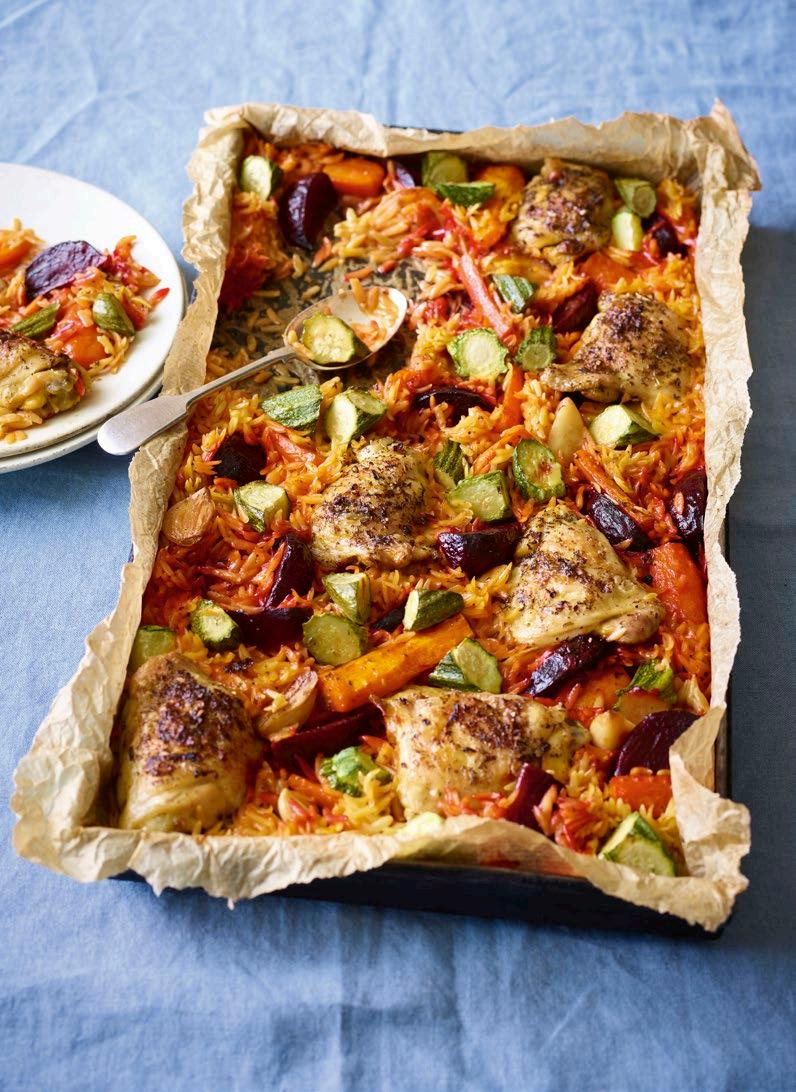
As a keen gardener and veg grower, this recipe, packed with vegetables as it is, combines two of my favourite things— cooking and gardening. In the summer it’s staple fare at home as there are always onions, carrots, beetroot and courgettes growing in the veg garden—in fact this is the reason the recipe came about in the first place! We grow garlic and French tarragon too, so really, the only ingredients that need buying are the orzo and chicken. For a vegetarian version, simply leave out the chicken and use vegetable stock.

1 Preheat the oven to 230°C/210°C fan/gas mark 8. Find a large, shallow roasting tin around 41 x 26cm and ideally no deeper than 4cm, and line it with a large piece of baking parchment (including up and above the sides).
2 Drizzle the paper with a little olive oil and arrange the chicken thighs, beetroot and carrots in the tin, spaced out in a single layer. Scatter over the garlic cloves. Drizzle with a little more olive oil, scatter over the tarragon and season everything generously with salt and pepper. Put into the top of the oven, turn the oven down to 220°C/200°C fan/gas 7 and cook for 30 minutes.
3 Remove from the oven, baste the chicken with the juices and turn the beetroot over (the point of a knife is best for this). Add the orzo, avoiding the chicken as you do so. Pour the stock into the tin around the chicken, ensuring all the orzo is submerged in the liquid and not sitting on top of the chicken, otherwise it won’t cook. Scatter over the courgettes, then return to the oven for a further 10 minutes.
4 Remove from the oven and stir the orzo around a little with a teaspoon to ensure it’s all submerged and cooking evenly. Turn the vegetables over and nestle them in, too, if necessary. Cook for a final 10 minutes, then remove and leave to stand for 10 minutes (or a little longer) before eating.
This recipe features in Jane Lovett’s latest book, Just One Pan (Headline Home, £25)
Serves 4
• olive oil, for drizzling
• 8 chicken thighs, skin-on and bone-in, well trimmed and snipped twice through the skin and flesh with scissors
• 4 small–medium (around 300g) raw beetroots, peeled, halved and each cut into six wedges
• 350g carrots, peeled, halved lengthways, larger ones cut into quarters lengthways
• 1 head of garlic, cloves separated and peeled (halve any larger cloves)
• 1 tsp dried tarragon sea salt and freshly ground black pepper
• 250g dried orzo
• 500ml well-seasoned fresh chicken or vegetable stock (or use two stock cubes)
• 3 medium courgettes (around 250g), cut diagonally into 2cm triangular chunks
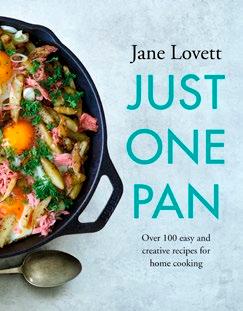

This month’s recipe comes from chef Elena Reygadas and her restaurant Rosetta in sunny Mexico City. Concha, meaning “shell” in Spanish, is a traditional Mexican sweet bread roll which gets its name from its round shape and the striped, seashell-like pattern


Make the vanilla crust: In a bowl, combine all of the ingredients and beat with an electric mixer at a low speed until well blended. Don’t overmix. Once the mixture is uniform, let stand at room temperature while you make the conchas.
Make the conchas:
1 Dissolve the yeast in the milk. In a large bowl, combine the flour, dissolved yeast, sugar, salt, eggs, and butter and mix with your hands, making small circles. Once everything has blended together, knead the dough, lightly striking it against the surface until it becomes smooth and elastic.
2 Place the dough in a covered container and let it sit at room temperature for 10 minutes. Divide the dough into 4 pieces and shape each into a ball.
3 Divide the vanilla crust into 4 portions; they should be about 20g. Form each portion into a ball and then use your palm to flatten it into a disc large enough to cover one of the dough balls.
4 Glaze each ball of dough with egg and cover with a disk of vanilla crust. Press a shell-pattern mould into the crust or make the traditional pattern with a knife. Dip each concha in sugar and place on a baking sheet. Cover the conchas with a lightly floured cloth and let sit at room temperature for 1–1.5 hours, preferably in a humid environment between 20–25°C. Preheat the oven to 175°C.
5 Bake the conchas for 18 minutes.

Makes 4 conchas

Ingredients:
For the vanilla crust:
• 10g all-purpose (plain) flour
• 10g vegetable margarine
• 5g sugar glass
• 5g sugar
• 0.5g baking powder
• Pinch of salt
• Seeds from 1⁄2 vanilla bean
For the conchas:
• 4g fresh yeast
• 15g whole milk
• 180g wheat flour
• 25g sugar
• 1g fine sea salt
• 45g eggs
• 40g butter
• Egg wash
Recipe taken from Today’s Special, 20 Leading Chefs Choose 100 Emerging Chefs, published by Phaidon
A simple and fun way to bring some green into your home
Every few months, I like to update my home decor for the new season. Nothing too complex; just easy changes like new wall art and throw cushions. These small touches can really transform a room, and keep it feeling fresh.
This month, I’ve been busy reflecting the summer season by adding bold greens and yellows to my space—including this handmade wall art. The layered monstera leaves strike a fine balance between simplicity and detail; it’s a statement piece, without being too over the top.
You will need Adhesive foam pads
Glue stick
Mid-weight card in shades of green
Heavy-weight backing card in white
Box frame
Pencil
Scissors

Mike Aspinall runs one of the UK’s most popular craft blogs, The Crafty Gentleman, where he shares free DIY tutorials
How to make it
1. Sketch out a few leaf shapes you like (you can search online for templates if you don’t want to draw them freehand). I’d recommend having 3-5 different shapes, so your art has lots of variety. I used a mix of summery palm leaves, monstera plants, and vines in mine.
2. Draw or trace your leaf shapes onto some green card. Make sure you use a range of different colours; this will help to create more depth. As a rule of thumb, I’d recommend:
• 3 large leaves (approx 1/4 of the size of your frame)
• 4 mid-size leaves (half the size of the large leaves)
• 3 small leaves (1/4 the size of the large leaves)
• 2-3 large, thin vines
3. Cut out all of the leaves, as well as a square of white card to mount them onto (this white card should fit neatly into your box frame). If you’ve chosen to include any monstera leaves in your design, it can look good to cut some holes in them too—this helps add additional depth and texture.
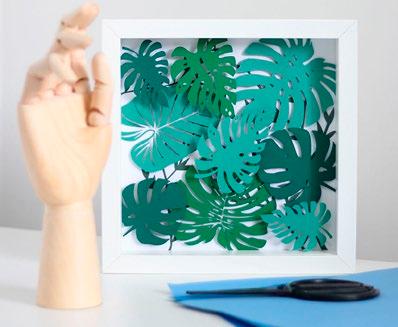
4. Before sticking the leaves down, make a loose plan of how you want to lay them out. Play with positioning and layers, until you achieve a look that you like (take a photo of your layout, so you can easily refer back to it).
5. Use a glue stick to apply the first layer of leaves to the white backing card. It’s good to start with some vine leaves or branches, as they effectively cover a lot of the backing card.
6. For the remaining leaves, use adhesive foam pads to stick them in place (available from all good craft shops and websites). These foam pads are a few millimetres thick, which is perfect for giving depth to a craft project. They couldn’t be easier to use: just peel off the backing and stick to your card. Simple! You can even layer several foam pads on top of each other to double, triple or even quadruple the depth.
7. Finally, trim any leaves that are overhanging the edges of the backing card. Then place the artwork into a box frame and secure in place.
Even when the clouds roll over and the sun goes away, this wall art will still add a pop of summer to my home! n







Despite many becoming mindful of the energy consumption within their own homes, the problems with energy waste largely start at the point of production
According to a report by the Association for Decentralised Energy, the UK wastes 54 per cent of the energy it produces, which amounts to a loss of £9.5 billion per year. Unsurprisingly, a large amount of electricity waste is from heat and a lack of proper insulation within homes and businesses. However, the dearth of efficiency within the electricity network is also largely to blame; a small number of large power stations dotted around the UK supply our electricity through incompetent pylons, meaning 54 per cent of the energy we produce is wasted before it even reaches our homes.

Created in 1937 when energy demands were significantly lower than our burgeoning power needs today, it’s no wonder that the ageing infrastructure of our National Grid no longer supports us. Power plants have become significantly more expensive to build over time, resulting in very few new ones being built and as such, more pressure is put on them to house larger quantities of electricity and distribute it over further distances—an extremely clumsy process that amounts
to a lot of waste. On top of this, an increased reliance on renewable energy and combined-cycle gas turbines has actually had an adverse effect on existing power plants. Despite renewable energy being a necessity for a sustainable future, the current system is not set up to support it. As fossil fuel plants have been shut down, we’ve had to import gas, a costly scenario that (while cleaner than coal) still creates damaging emissions. To further this obstruction, renewable energy is often intermittent and would work most reliably with an energy storage solution— incorporating it into an ageing system is an added strain. While we remain using this energy arrangement, costs will only continue to rise as production expenses do, and the financial burden will be placed onto consumers. Using less energy during everyday tasks is a solution to part of the problem, but that alone won’t bring us away from vulnerability. We must also be more shrewd with how we use energy, eliminating peaks in our energy demand to permit for power plants with lower generating capacities that suit our needs. n
by Jessica Lone SummersHow did you become an authority in energy conservation?
I started my career in internet data centres where huge amounts of electricity are used. I faced many challenges getting access to enough power from the grid, but also saw the opportunity to make energy usage greener and more intelligent. That’s when I decided to work in the new “smart grid” sector, applying technology to generate, store and manage electricity to reduce carbon emissions.
How does Powervault help our planet?
Powervault manufactures home electricity battery storage systems which do several things to reduce homeowners’ CO2 emissions. First, we store your surplus solar PV energy during the day (rather than exporting it to the grid when the grid does not want it) to use in the evening at home, thus reducing the load on the grid at its carbon intensive evening peak. Second, thanks to its intelligent algorithm, the Powervault works with new “time of use” electricity tariffs such as Octopus Agile so that you only import electricity from the grid when it is low cost and low carbon intensity, to store in the Powervault for use when the grid electricity price and
carbon intensity is high. Third, Powervault provides support services to the grid as Powervault batteries are available for the grid to “dip into” when there is a short term local supply issue.
What changes need to happen to implement sustainable energy for good?
We need to revolutionise the way we use clean electricity to deliver our CO2 reduction targets. We need to double or triple our generation of clean electricity so we can power our vehicles and heat our homes using renewables rather than fossil fuels. We need to invest heavily in making the grid smarter, and able to store electricity to support this increase in renewable generation and electricity consumption. If we don’t do this we will miss our CO2 reduction targets. Government policy needs to change and we need to change our individual behaviour. The government needs to reduce VAT to zero on green energy products. Currently we pay 20% VAT to buy solar PV panels or electricity storage, yet only 5% VAT to fill up domestic oil tanks, despite the fact that the UK is legally committed to a journey to net zero by 2050! As individuals we need to commit to buying and doing the “right” things. n

For more information, visit powervault.co.uk
Still unsure about stepping into a charity shop to update your wardrobe? Let Catherine Summers change your mind
Now that non-essential shops are back open, it means I can once again indulge in my obsession of pre-worn clothes shopping in person, not just online.
Etsy and eBay are my online vintage shopping outlets of choice, but I’m just as partial to a good rummage through charity shops and vintage clothing stores. Pre-worn, pre-loved, vintage, second-hand. I love it all.
My infatuation with vintage clothing started at the age of nine. I stopped my mother donating a psychedelic floral jacket and matching shorts set that was likely a hand-me-down to my older sisters. By the time I got my eager hands on it (the early 1980s), to everyone but me it seemed like a hideous Sixties relic and deeply unfashionable.
Undeterred, I wore that flower power suit with pride—much to the disgust of my sisters. I can even

Catherine Summers is an award-winning fashion blogger, posting regularly on her website, notdressedasalamb.com and on her Instagram account, @NotLamb
remember my mother gingerly asking, “Are you sure you want to wear this?”, though I thank her for allowing me the freedom to (for the most part) wear what I liked.
While wearing clothes worn by others is an abhorrent thought to some, those of us who love the unique looks we create with pre-worn usually love the hunt for the right piece as well. What on earth could be more satisfying than scouring the rails or wading through an online search, eventually finding that special gem of an item, knowing that you’re not contributing to the 20 per cent of the global industrial water pollution caused by the textile industry?
Eco credentials aside, the best thing about wearing vintage is that you’ll never turn up to an event and bump into someone wearing the same thing. Back in the pre-COVID days when I attended any event with a cocktail, I would nearly always look at buying vintage first. I once went against my own judgement and bought an (albeit stunning) off-the-rail red gown for an awards event, only to spend the first half hour panicking that someone else might be wearing the same dress. You have no such fear with vintage.

I’m currently going through a phase of seeking out the very best in 1960s and 1970s shirts and blouses.
Blame it on period dramas like The Queen’s Gambit, but I just can’t get enough of the loud patterns and long collars. I know this look isn’t for everyone, but buying vintage doesn’t have to mean looking like an extra from Austin Powers.


compared to trousers (if you’re not shopping in person, don’t forget that a vintage size 14 is more like a modern size 10, so check measurements carefully). Keep an open mind and think about what it’ll work with in your wardrobe. Remember, mixing vintage pieces with modern will help you avoid the period-costume look.
If you’re a vintage newbie, start with something small, like a vintage silk scarf or a piece of jewellery. Once you’re willing to be more daring, dresses and blouses are always a good bet and easier to get the fit right
Vintage doesn’t date. It’s already dated, if you like. I guarantee that the 1950s dress you’re currently eyeing up will still look just as good in five,ten years' time. Just don’t blame yours truly when it becomes as much of an obsession for you as it has for me. n
When it comes to oral care, Jenessa Williams finds out whether water irrigators are really worth the flossing fuss
Though our dentists may despair, flossing is one stage of dental care routines that many of us let slip, not liking the feel, mess or environmental waste of synthetic string. Oral irrigators—otherwise known as water flossers—have traditionally been more of a specialist tool, but are surging in popularity at home as more and more people look for a way to clean the areas a traditional toothbrush can’t always reach. Similar in design to an electric toothbrush, they are designed to send out a jet of water that can be directed between teeth and gums, helping to remove tightly-wedged food debris and bacteria.
With various models on the market, strength of the water jet (and, therefore, the tool’s efficiency) will vary depending on how bulky a unit you’re willing to invest in. Most highend irrigators can be adjusted for pressure—for those with oral sensitivities or tightly-packed teeth, they’re a soothing way to remove debris from sore gums, crowns or
braces, not using the same abrasive technique as string floss. They’re also much easier to manoeuvre—while typical floss requires something of a dexterous "C-shape" technique to be fully effective, the water jet-stream equivalent can essentially be a point and go, easily cleanable and shareable between family members.
Water irrigators can work wonders, but for true tip-top teeth, you shouldn’t necessarily be dumping your spool of regular floss just yet. According to experts, water flossers work best in conjunction with regular tooth brushing and flossing rather than as a replacement—while they are great at tackling debris, they won’t necessarily do much for more stubborn plaque. Adding them to your routine is still a good idea, but there’s no foolproof excuse to avoid those every-sixmonth dentist check-ups just yet… n


Jeyes Fluid, the British heritage brand that’s been proudly keeping the nation’s gardens clean for over 140 years, has leaped into the future with its brand new recyclable plastic bottle and updated formula. After two years of development and testing, the revamped bottle is kinder to the planet and the new formula can be used on more surfaces. It is available in major retailers from £4.49.
Founded in 1877, Jeyes Fluid has been trusted by British households for its antibacterial power that’s withstood the test of time. This includes being granted the prestigious Royal Warrant by the British Royal family. From sterilising the trenches in World War I, to reducing the spread of scarlet fever in the 1870s, to now keeping gardens safe through the pandemic, Jeyes Fluid has been passed down throughout ages.
Moving into the next generation, Jeyes heritage tin bottle has been replaced, as part of its commitment to help pave the way for a more sustainable future. The new, ergonomically designed, recyclable bottle with paper labels mirrors its predecessor in terms of its iconic tin shape for easy recognition on store shelves. It’s also lighter to reduce transport emissions and removes a layer of factory manufacturing and pollution.
For years, Jeyes Fluid has been identified by it’s dark thick liquid - that’s all changed with an updated formula that kills 99.9% of bacteria and
For further information about Jeyes products, please visit: www.jeyesfluid.co.uk














continues to be DEFRA approved against avian influenza. The brown dye from the solution has been removed to ensure it can be used on all surfaces, including lighter ones, without staining them. Additionally, the outdoor cleaner now tackles limescale and rust, along with bacteria, welcome news for gardeners in areas with hard water.

Charlotte Blampied, spokesperson for Jeyes, comments; “As Jeyes Fluid moves into an exciting new era, we look forward to loyal customers enjoying this recyclable bottle, while it stays true to its heritage. With our modern look & easier to use formula we’re appealing to a younger audience whom we want to connect with the brand and encourage to get out in their gardens and clean their outdoor spaces on a regular basis. Jeyes continues to be a trusted household cleaner by millions globally, a true testament to the quality of the product. We will be continuing to developing and evolving the brand’s packaging further as part of Henkel Laundry and Homecare’s commitment to sustainability.”
Jeyes Fluid eliminates bacteria in garden and outdoor spaces. It e ectively cleans a multitude of surfaces, helps to clean drains, limescale and rust on outdoor tables and chairs, decking areas, plant pots, greenhouses, pathways, driveways, garden sheds and more.


This is not your typical road movie. Sure, there are the long drives, chance encounters with colourful characters and elegiac sunsets over cliffs, yet they’re not marked by the traditional sense of fun and exhilaration that usually accompanies them. In Nomadland, they’re swapped out for stultifying solitude, grief, and coming face-toface with the uncertainty of living a life without safety nets.
Frances McDormand stars as Fern—a recent widow who loses everything to the Great Recession, packs her bags and embarks on a journey through the American West with just her van to call home.
Life on the road is not without its difficulties: flat tyres, ant infestations and cold nights in the desert are just a handful of things that Fern needs to
learn to navigate. Luckily, she gets guidance from a welcoming community of seasoned fellow “nomads”. With their help, Fern learns basic survival and self-sufficiency skills and makes friends for life.
At first glance, you’d be forgiven for expecting the film to be a tad monotonous; the bare landscapes, sparse dialogue and sterile colour palette don’t exactly promise a “feast for all senses”. Yet there’s something irresistibly magnetic about the contemplative nature of Nomadland. We’re there with Fern through thick and thin: chattering our teeth at night; looking for a place to take a leak in the middle of a windy valley—and yet somehow, we wish this trip would never end.
By Eva Mackevic
A trippy, freewheeling cult classic starring Peter Fonda and Dennis Hopper as two bikers traversing the wide open west. Stunning American vistas, a rocking soundtrack, a quintessential Sixties vibe and one of Jack Nicholson’s greatest supporting roles ever— what’s not to like?

Wim Wenders was arguably at his best, directing this wistful, poetic slice of cinema about an aimless drifter who wanders out of the desert and must reconnect with society and his own family. Musicians Kurt Cobain and Elliott Smith claimed this was their favourite movie of all time.

Hailed as one of the greatest films about female solidarity ever made, Thelma & Louise follows the story of two friends en-route to a weekend getaway at a fishing cabin in the mountains. After stumbling into some severe trouble, Thelma (Geena Davis) and Louise (Susan Sarandon) find themselves wanted for serious crimes and on the run from the police.

Echoing the spirit of Nomadland, Into the Wild tells the story of a talented young graduate who throws it all away to set out on a journey to the Alaskan wilderness with minimal supplies, hoping to live simply off the land. Based on the true story of Chris McCandless, director Sean Penn waited ten years to make the film to make sure he had the approval from the McCandless family.
Based on a true story, this inspiring adventure film traces the youthful road trip of friends Che Guevara and Alberto Granado. Their quest was to see things they’ve only read about in books

With crowded sets deemed a COVID-era liability, TV is becoming overrun with disembodied voices. Can’t Get You Out of My Head (iPlayer) finds Adam Curtis narrating a typically idiosyncratic account of recent history over footage retrieved from the BBC archives. Whether the grand theory holds water—and whether Curtis has any cure for the dysfunction he diagnoses—is arguable, but individual stories prove compelling, and his layering of sound and image to land key points remains unparalleled on British television. Properly provocative viewing, it’ll likely pinball around your own head for days.
Calls (Apple TV+) TV, but it’s a clever cheat. Over nine episodes, we’re watching an apocalyptic event—involving a glitch in the time-space continuum— play out via telephone conversations illustrated with text and graphics; the starry cast are
literally phoning it in, heard but never seen. Yet the series, adapted from a French original, hooks: its Twilight Zone-ish yarn—or bundle of yarns—develops ingeniously, as the characters begin talking at cross purposes, and the fabric of the universe warps before our very eyes.
After all that, light relief may be required. The Flight Attendant (Sky One; NOW TV) is a fizzy blackcomic thriller—an airport novel with ad breaks—in which Kaley Cuoco channels Goldie Hawn as a stewardess who wakes up next to a corpse after a drunken fling; alternatively, Taskmaster (C4; All4) is back for its 11th series, putting another crack squad of comedians (headed, this season, by Lee Mack) through a bootcamp of absurdist challenges. Slowly, bodies are returning to studio floors— even if those studios are still audience-free, and the bodies carefully distanced.
 by Mike McCahill
by Mike McCahill
TheAdamCurtisCollection (iPlayer)
If his latest has you thinking, revisit Curtis’s earlier work—from his early shorts to his landmark ThePowerofNightmaresand TheCenturyoftheSelf.

Archive Series Volume No.5 : Tallahassee Recordings by Iron & Wine
Sam Ervin Beam, better known by his stage name Iron & Wine, is easily one of the greatest American songwriters of his generation, with nine albums under his belt and loads of contributions to film and TV. Here, he reveals what would have been his debut LP that somehow got lost in time. Recorded in the late 1990s with his then-roommate while he was a film student in Florida, Tallahassee Recordings is a gentle foreshadowing of the artist’s impressive songwriting craft that we’ve all come to love about him. It’s a soothing, intimate collection of folk songs about identity, love and women; the Jennies, Lucies and Valentines of his life or, perhaps, imagination, and the lingering trace of their perfumes, words and smiles in his memory. Though he was very young when making this album, the lyrics are discerning and insightful, delivered with self assurance and almost a matterof-fact ease.

You Might Also Like…
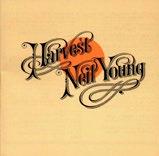
Harvest by Neil Young (1972)
It’s also a gorgeously recorded album: though the instrumentation is limited to a guitar, bass, harmonica and drums, you can hear the subtlest squeaks of fingers moving through the fretboard and Sam’s peaceful breathing as he plays the harmonica or sings. Reminiscent of Leonard Cohen and Nick Drake in its sleepy, lilting nature, Tallahassee Recordings feels like a sit down with an old school friend whom you haven’t seen in years. Thank you, Sam, for ditching the filmmaking.
by Eva MackevicHarvest is arguably one of Neil Young’s best-known albums; the kind that even people who don’t really like Young, own. An earthy, easy-going record, it’s defined by the mellow Nashville sound of the steel guitar and the simple lyrics that divulge vulnerability and disarming sincerity. There’s a reason for Harvest’s overall subdued sound though: due to a crippling back condition, Young was unable to pick up an electric guitar and recorded most of the album while in a back brace. Therefore, most of his instrumental contribution was acoustic.
Adele Parks returns with another blood-curdling thriller about the mysterious disappearances of two women
Both of You by Adele Parks (HQ, £14.99)
One thing you can say with confidence about Both of You is that it’ll be a bestseller. After all, ever since Adele Parks expanded the dark edge of her earlier romances into full-on domestic noir, her novels haven’t just featured on the bestseller lists, they’ve topped them.
Given that it opens with a woman called Leigh tied to a radiator in an empty room, it’s clear that her new one will be pretty dark too—although not in the way you might expect. As Leigh fills us in on her pre-kidnap life, it seems for a while that we’re in for Rebecca-like tale, with Leigh worrying that she

James Walton is a book reviewer and broadcaster, and has written and presented 17 series of the BBC
Radio 4 literary quiz
The Write Stuff
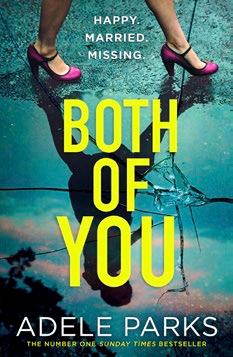
doesn’t match up to her husband Mark’s late first wife. In fact, the book proves far stranger than that.
It’s also, as we literary critics say, a bugger to review—since most of the action hinges on an unrevealable twist a third of the way through. What I can tell you is that Mark reports Leigh’s disappearance to the police, and that it’s soon followed by the mysterious vanishing of another wife, Kai, who also fills us in on her marriage.
Between them the two women build intriguingly to that big twist. The
trouble is that, once it’s happened, the novel loses momentum. This is mainly, I’d suggest, because Parks feels (probably rightly) that the twist is a bit implausible and so goes to great, often repetitive lengths to justify it, instead of simply letting us suspend our disbelief. At one point, Kai is caught in a lie, and realises that, “The more I said, the less convincing the story was”: a lesson Parks herself would have done well to absorb. Fortunately, after its overlong central section, the book does then roar back to life for a properly frightening climax.
Both of You undeniably offers plenty to enjoy, not only in its more obviously thrilling moments, but in the shrewd eye it casts on families and conflicting female desires. Yet it also rather confirms my theory that when writers become as successful as Parks, their editors no longer feel able to say, “You really need to lose at least 50 pages from this.”
Can you guess the writer from these clues (the fewer you need the better)?
1. His fiction debut was Britain’s bestselling novel of 2020.
2. His brother is the bassist in the band Suede.
3. He’s the co-presenter of the TV show Pointless
Answer on p126
BritishSummerTimeBegins:The SchoolSummerHolidays19301980 by Ysenda Maxtone Graham (Abacus, £9.99). Gloriously nostalgic oral history of the way we were—and Britain was—in those endless childhood summers long ago.
Us Three by Ruth Jones (Black Swan, £8.99). Three primary school friends pledge everlasting allegiance on a Curly Wurly wrapper—but it’s then thoroughly tested by adult life. Warm, funny novel by the co-writer of Gavin andStacey
The Windsor Diaries by Alathea Fitzalan Howard (Hodder, £10.99). Revealing journals of a teenage aristocrat who spent the war at Windsor Castle with Princesses Elizabeth and Margaret.
The Golden Rule by Amanda Craig (Abacus, £8.99). A woman persuades a stranger to murder her husband in this gripping novel. But is she telling the truth about him?
MyLifeinRedand
White by Arsène Wenger (W&N, £8.99).
The long-serving Arsenal manager reflects illuminatingly on his life and career.

Can a doctor’s diagnosis make you iller than you are?

Often, when we describe a medical condition as “psychosomatic”, what we actually mean is “not real”. But this is a mistake that nobody who reads Suzanne O’Sullivan’s endlessly thought-provoking book is likely to make again. As she demonstrates through a collection of fascinating case studies from across the world, just because you’re suffering from an illness not caused by any disease, that doesn’t mean you’re not suffering from an illness.
According to O’Sullivan (a London-based neurologist), every illness has—to a greater or lesser extent—three elements. Two are the physical and the psychological, with our fear that there might be something wrong causing the brain to pick out aches and pains it would normally leave in the background as part of the body’s “white noise”. The third is cultural: that people learn from those around them—and from their communities’ prevailing beliefs—the form the illness should take.
This certainly applies to the book’s most striking cases: girls from immigrant families in Sweden who take to bed unable to move or eat for months, even years; the US embassy staff in Cuba in 2017 who believed they were being attacked by some sort of sonic ray in what had long been an enemy country, and developed shared symptoms that no tests could explain.
But the same thing also affects our more everyday experiences of medicine. For O’Sullivan, one problem in the West is over-diagnosis. On the whole, people feeling ill want to have a known disease diagnosed, and doctors want to find one. But what if the symptoms are a signal that something else in their
lives isn’t right? In fact, a diagnosis can lead to people acting—and even being—iller than they are…
There are numerous examples of how Western medicine has made patients out of people who were previously perfectly well. For example, in 2002, a group of experts formed a committee to develop criteria that would allow the early detection of kidney disease. Renal failure is life threatening and life destroying; it is devastating to the individual and costly to the health service. The committee assumed that, by creating criteria inclusive enough to detect the earliest signs of kidney disease, they would ultimately be able to reduce the number of cases of kidney failure and thus save lives. That all seems very admirable, until you see the consequences of their work. The application of their criteria meant that, almost overnight, a substantial number of people who didn’t know they had a disease, and weren’t necessarily looking for one, were suddenly told they had a medical problem. It was estimated that 10 per cent of people in the US and 14 per cent in the UK fell into the expanded category for kidney disease. That compares with rates of less than 2 per cent before the criteria change. A problem arose with the number of new cases: if they were to be believed, as many as a third of
people over 65 could be heading towards kidney failure. But, since only one in a thousand people actually develops end-stage renal failure, that could not be correct. The mismatch in numbers meant that the vast majority of those newly labelled with chronic kidney disease would never have progressed to serious kidney disease if left alone. Thus, a huge population of asymptomatic people were burdened with a diagnostic label, accompanied by the need for regular check-ups and tests they almost certainly didn’t need.
A very large number of healthy people had become patients through nothing more than an expanded disease definition. Most of those people will not have been aware that an arbitrary and overgenerous shift in a dividing line was enough to make them sick. They put trust in the medical community and in science, not knowing there was so much ambiguity in medicine.
Obviously, over-diagnosis creates the inconvenience and risk of
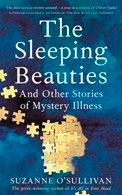
unnecessary treatment, but what concerns me are the psychological and behavioural effects. Of course, the beauty of a very inclusive preventative programme is that if you treat too many people and almost none develop the disease, you can hail it as a success. The patients will probably even praise you, not realising they never really needed all those doctors’ visits, blood tests, scans and supplements.
But a negative consequence of over-diagnosis that is hard to measure is how people embody their new identity as a sick person. I wonder how many of those who were told they had kidney disease became excessively concerned about their health, searched their bodies for symptoms and limited their activities. People regard medical diagnoses, especially those based on scientific-looking test results, as infallible truths, when, in fact, they are only too fallible.
’’
And the name of the author is… Richard Osman, whose bestselling debut is TheThursdayMurder Club: a funny, charming and properly twisting whodunit—out in paperback this month.

InthePsychiatrist’sChair by Anthony Clare. A collection of interviews with celebrities, this is one of the first open conversations about mental health I ever encountered. It is a tribute to Clare’s charisma and sensitivity that he made such conversations possible.
TheConsolationsofPhysics
by Tim Radford. Here is a love story with physics. Radford marvels at the miracles of the universe in such a compelling way that he made me marvel too.
Into the Silent Land by Paul Broks. I have never come across any book about the workings of the brain as beautifully written as this. Poetic and literary.
Behave:TheBiologyofHumansat
Our Best and Worst by Robert Sapolsky. An all-encompassing journey into humanity, written with Sapolsky’s characteristic humour.
The Immortal Life of Henrietta
Lacks by Rebecca Skloot. Fascinating and disturbing. I adored every moment of this wonderfully detailed book which tells the story of one woman’s incomparable (and inadvertent) contribution to science.
Best-loved children’s author Terry Deary, the mastermind behind Horrible Histories, has written over 200 books. His latest, Horrible Histories: The Secret Diary of Henry VIII is out 6 May, (Scholastic).
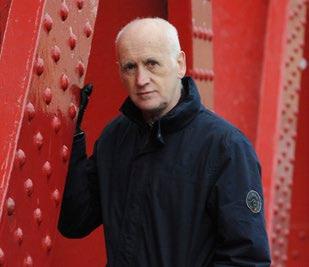
My school texts, like the Thomas Hardy we were forced to read, were so dull. When I came across this Chesterton book at the age of around 17, I realised that books could be exciting and create colourful new worlds. I understood that books didn’t have to be serious and filled with miserable heroes like Tess of the D’Urbervilles or the Mayor of Casterbridge. They can lead to a meeting with fantastical people. Chesterton made me a writer.
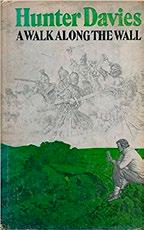
If school literature was boring then school history was torture. When I picked up Hunter Davies’s account of a journey along Hadrian’s Wall, it opened my eyes to how history can be a living subject—not just dead people and dusty dates. I lived 20 miles south of the wall and this book made me want to visit it. At the age of 65 I even ran the length of it for charity. Dull history books can give facts; heritage sites can generate understanding. Hunter Davies made me an historian.
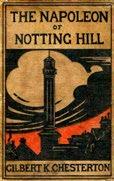
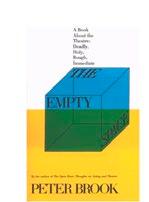
As a theatre student I read Brook’s book and the opening sentence informs every one of the 50 or so plays that I’ve written. “I can take any empty space and call it a bare stage. A man walks across this empty space, whilst someone else is watching him, and this is all that is needed for an act of theatre to be engaged.” Unforgettable. That “someone else watching” is the key. The audience is an equal part of a theatre experience with the actor. Peter Brook made me a playwright.
James O'Malley's lowdown on all the best tech for working from home
After a year of lockdown, many of us are now Work From Home veterans. We know our Zoom from our Teams, and sometimes we even manage to step outside at lunchtime to remember what sunlight and fresh air feel like. But even though—fingers crossed—the future may soon involve trips to the office and interaction with real, live humans once again—“WFH” is here to stay, as businesses big and small find they can function just as effectively, wherever their employees are.
So if you haven’t already, now is the time then to take your WFH setup seriously. Here are three techie improvements that'll make the place you currently spend 40 hours a week that little bit more bearable.
First, let’s talk screens, as that is what you spend thousands of hours every year looking at. If you’ve spent the last year working from a tiny laptop screen, it’s time for an upgrade. Less than £200 will bag you a large
monitor to plug your laptop into, which means you’ll be able to fit much more comfortably on the screen.
If you want to spend a little more, ultra-wide displays are the latest must-have tech. These are screens that are the same width as two regular-sized monitors—a 24:9 or 32:9 width to height ratio, compared to the conventional 16:9. These are wide enough for your windows to luxuriate, so you can keep an eye on Zoom, your inbox and whatever documents you’re working on without having to constantly flip between apps. And they tend to start from as little as £350, even for namebrands like Samsung and LG.
Next, what about those all important video meetings? First impressions are now made digitally, so it is important to appear professional when your face appears on screen. Before spending a single penny, make sure that your camera is roughly level with your eyes, so that your colleagues don’t find
themselves peering up your nose. But there is more you can do.
If you have a low-quality, grainy camera, then buy a better one that will plug in by USB. A Logitech C920, for instance, will set you back around £60 but will capture your face in full high definition.
FIRST IMPRESSIONS ARE NOW MADE DIGITALLY, SO IT'S IMPORTANT TO APPEAR PROFESSIONAL ON SCREEN
Or you can even make use of the really excellent camera you already own: your phone. Connect your iPhone via USB and you can use the app “Camo” as a replacement webcam. If you have a reasonably new phone the results are spectacular. And even better, if you’re a photography buff, and have a pricey Canon EOS DSLR camera to hand, Canon now offers software for download that’ll turn your big, professional camera into a TV broadcast-quality webcam too.
Sometimes though, you just need some more light. So consider positioning a light to point towards your face to ensure that you are sufficiently illuminated. If you really want to go the extra mile, you can even splash out on a specialist lightbox from Boling, for around
£129, which is designed for photographers but will also let you pick the perfect hue to light your face with.
And finally, what about your actual desk? With everything happening remotely, it is important to still get up and move around, so if you really want to push the boat out, consider a motorised standing desk.
These start from around £200 and are made by companies like VonHaus and iMount, and all work on the same principles: motorised legs enable you to have your desk as high or as low as you want, and can be controlled with buttons to adjust the height.
This means you can start the day standing while you check your emails, before hitting the “down” button and pulling up your chair to work more comfortably on that report you need to finish. Just be careful how you arrange the wires and chords plugging everything in though, as if you haven’t secured them with enough slack, maneuvering your desk could quickly lead to that expensive ultra-wide monitor you just bought going splat.
Ultimately, my point in this column is this: if you can afford it, it is time to treat yourself. You’ll almost certainly be spending a day or two every week working in the spare bedroom from now on until you retire. So consider this permission for you to spend some money to do WFH right! n
Win £30 for your true, funny stories!
Go to readersdigest.co.uk/contact-us or facebook.com/readersdigestuk
I love sheepskin rugs and own the largest one I could find, made from two pelts. Seeing a much bigger one on a market stall one day, I called to my husband, "Look, a four-skin rug!" and was briefly left wondering why people were looking at me and giggling while he pretended he wasn't with me.
JANET LAING, CambridgeshireI was looking after my four-yearold granddaughter for the weekend at her house, and had to also look after their cat who had had an operation and was being kept in for the weekend.
As I cleared up his litter tray, I noted the cat kept staring at me. I joked with my granddaughter that he didn't seem to like me.
"That's because, Grandma," she said in a very matter of fact voice, "He is wondering why you're stealing
all his poop with that little spade."
SHULAH CLARKSON, NorfolkDan, aged seven, was trying to open a bottle of paracetamol. I took it from him, opened it easily, and explained, "It's got a child lock on it, so that children can't do it, because that could be dangerous."
He pondered for a moment, then asked,"But how did it know I was a child?"
PENNY WARD, DundeeDuring a particularly stressful time when my cousin Rehanna was hospitalised and put on a ventilator for pancreatitis, the emergency doctors in Canada thought it best to have a telephone conference with our extended family to discuss the threat of pancreatitis on my cousin's life.
The doctor said he hoped "his call would provide our family with some relief and a reduction in our fears".

"ONE MINUTE, GRANNY, I'M JUST CHECKING MY INSTAGRAM"
My mother, who is hard of hearing, was listening in on the call and later told me, "It was nice of the doctor to offer us a reduction in airfare; not many doctors are so generous".
I listened back to the call recording and had a good hearty laugh which was desperately needed—obviously, my mother thought the doctors wanted to make us feel better by offering us reduced airfare!”
SHARON OSMAN, KentMy elderly aunt was rushed to the hospital by an ambulance with what eventually transpired to be a burst appendix. Major surgery and several pints of blood later, she luckily made a good recovery.
When, post operatively a nurse arrived to take some blood to test, my aunt helpfully advised her, “Oh, didn't anyone tell you? I don't think you'll need to do that for me because
the blood I have now isn't mine.”
JOANNE THOMAS, SuffolkI am a dentist. A patient once came in for a filling and an extraction. Upon completion of treatment, the patient expressed his displeasure over having an amalgam (metal) filling, stating, "I will drown when I swim from now on". I immediately responded stating that is the reason I had extracted a tooth—so that he could float. The patient left the surgery smiling.
One day I was reading the story of Chicken Little to my class. I came to the part of the story where Chicken Little tried to warn a farmer. I read, “…and so, Chicken Little went up to the farmer and said, ‘The sky is falling, the sky is falling!’”
I paused, then asked the class, "And what do you think that farmer said?" One little boy raised his hand and retorted,
"I think he may have said, ‘Good grief! A talking chicken!’”
ANNA HAMMETT, CheshireI overheard this on the tube when I was working in London. Parent to child: "Please tell me you just borrowed this report off the most stupid person in your class to give me a good fright before you hand me yours?"
LOIS JONES, Clwyd cartoon






YES I want to subscribe to Reader’s Digest Magazine for just £3 for 3 issues (a saving of £8.37 on the shop price of £11.37 based on the cover price of £3.79 per issue). I understand that if I do not wish to continue receiving Reader’s Digest after my first 3 issues I can simply cancel my subscription by contacting customer services. If I do want to continue to subscribe after my first 3 issues I need do nothing and my subscription will automatically be renewed at the low rate of £7.50 for every 3 issues until I decide otherwise. Name: Address:

Precision sometimes requires big guns. Drop the following words, each clocking in at 14 letters or more, into your conversation and give your ideas new weight
BY ROB LUTES1. contraindicated—A: rudely refuted. B: inadvisable for medical treatment. C: proven wrong.
2. quadragenarian—A: person between 40 and 49 years old. B: having four corners. C: able to write with one’s feet.
3. punctiliousness—A: devil-maycare bravado. B: exaggerated and outrageous cruelty. C: strict attention to detail.
4. scolecophagous—A: wormeating. B: burrowing. C: lacking a skeleton.
5. noctambulation—A: postoperative care in which a patient gets out of bed at night. B: sleepwalking. C: violent outbursts during sleep.
6. gedankenexperiment
A: thought experiment. B: scenario that explores moral judgement. C: test to determine mental acuity.
7. prestidigitation—A: mathematical shortcut. B: sleight of hand. C: massage technique using fingertip pressure.
8. podobromhidrosis—A: deep muscle pain. B: slurred speech. C: smelly feet.
9. bouleversement—A: reversal. B: celebration. C: critique.
10. disambiguation—A: unsolvable philosophical quandary. B: reversal of position in a debate. C: clearing up confusion.
11. anthropomorphic—A: having human characteristics. B: frequently changing. C: extremely old.
12. bowdlerisation—A: dissolution of country following war. B: removal of offensive material from a text. C: falling into disrepair.
13. insurrectionist—A: rebel. B: pessimist. C: builder.
14. tintinnabulation—A: belief in angels. B: abstruse mathematics used in alchemy. C: ringing of bells.
15. sesquipedalian—A: unrestrained merrymaking. B: employing big words. C: having the ratio of one and a half to one.
1. contraindicated—[B] inadvisable for medical treatment; The drug cured older patients but was contraindicated for anyone under 18.
2. quadragenarian—[A] person between 40 and 49 years old; Being a quadragenarian is no longer reason enough to retire as an athlete.
3. punctiliousness—[C] strict attention to detail; Martha’s punctiliousness was evident as she polished every knife on the table.
4. scolecophagous—[A] wormeating; The moles were scolecophagous, so Avelino fed them earthworms.
5. noctambulation—[B] sleepwalking; The third time she woke with mud on her feet, Terri knew she had to fix her noctambulation.
6. gedankenexperiment [A] thought experiment; The job offer in Antarctica was tempting, so Azra did a gedankenexperiment and tried to visualise himself there.
7. prestidigitation—[B] sleight of hand; Making cards appear and disappear, the magician wowed the children with his prestidigitation.
8. podobromhidrosis [C] smelly feet; The second that the patient removed his shoes, his specialist, Dr Dao knew that his
podobromhidrosis was back.
9. bouleversement—[A] reversal; In an economic bouleversement, the Canadian dollar was nearly 20 cents higher than that of the US.
10. disambiguation—[C] clearing up confusion; The prime minister’s cryptic words about Quebec required swift disambiguation by his aide to prevent a political storm.
11. anthropomorphic—[A] having human characteristics; The popular new cartoon was filled with anthropomorphic dinosaurs.
12. bowdlerisation—[B] removal of offensive material from a text; The censor’s cuts to Daryush’s novel amounted to the worst bowdlerisation the critic had ever seen.
13. insurrectionist—[A] rebel; The sudden seizure of his home transformed Augustin into an insurrectionist against the government.
14. tintinnabulation—[C] ringing of bells; On Sundays, Rome came alive with tintinnabulation from hundreds of churches.
A feudal tenant ranking directly below a baron Alternative suggestions: "A full of life dinosaur"
15. sesquipedalian [B] employing big words; My boss told me to cut out the sesquipedalian reports.
VOCABULARY RATINGS
7–10: fair
11–12: good
13–15: excellent
1. Which Star Trek actor stormed the beach at Normandy during the Second World War as part of the Canadian infantry?
2. Prince William’s Earthshot Prize promises 1 million pounds for solutions to what kind of global problem?
3. Tunnels, road closures and human-assisted crossings aid the migration of what animals in Europe and Canada?
4. What was distinctive about baseball pitcher Jackie Mitchell, who struck out Babe Ruth and Lou Gehrig during a 1931 game?
5. What fiction genre addresses the effects of climate change?
6. What European country plans to house all residents by 2027?
7. What British screen legend reads bedtime stories on her new family podcast?
8. Velocipede, penny farthing, gravel, randonneur and folding are all types of what?
9. Which centenarian was featured on the cover of Guinness World Records 2021 after breaking two records in 2020 and passing away earlier this year?
10. Astronauts have compared what attribute of outer space to hot metal, seared steak and raspberries?

11. The proposed Jane Goodall Act seeks to ban all imports of what animal product into Canada?
12. According to legend, Pharaoh Pepi II had servants cover themselves in what substance in order to lure flies away from him?
13. At 4,528 metres, Mount Kirkpatrick is the highest peak of which mountain chain?
15. In efforts to create bespoke products, some beauty companies are collecting DNA from clients to map the microbiome of what organ?
14. Rubik’s Cubes, magic squares and logic puzzles are examples of what branch of mathematics?
Challenge yourself by solving these puzzles, then check your answers on p139
Reveal a hidden picture by shading in groups of horizontally or vertically adjacent cells. The numbers represent how many cells are in each of the corresponding row or column’s groups (for example, a “3” next to a row represents three horizontally adjacent shaded cells in that row). There must be at least one empty cell between each group. The numbers read in the same horizontal or vertical order as the groups they represent. There’s only one possible picture; can you shade it in?
Simone decides to create a variant of the game rock, paper, scissors. It will feature five elements. So far, she has decided that:
✦ Water puts out fire
✦ Fire melts metal
✦ Water rusts metal
✦ Air blows away earth
Simone will ensure that the new game is balanced, meaning that each element wins against as many other elements as it loses to. Under this system, between earth and fire, who wins?
A diner offers three options for breakfast:
✦ bacon and eggs
✦ pancakes
✦ sausage and hash browns If four college students come in, the waiter could get any of 81 different orders, since each person could ask for any one of the three things, and 34 = 81.
Unlike the waiter, the cook doesn’t need to know which customer gets what: he only needs to know how many of each breakfast plate to make (for example, three plates of bacon and eggs and one plate of pancakes). Considering this, and assuming that each student asks for only one breakfast plate, how many different possible orders are there that the cook could receive?
Can you locate 12 hidden treasures in the empty cells of this grid? The numbers outside indicate how many treasures are in each row or column. Each arrow points directly toward one or more of the treasures and does not share a cell with one. An arrow may be immediately next to a treasure it points to, or it may be further away. Not every treasure will necessarily have an arrow pointing to it.
How many triangles are there in the figure below?
Earth does. To be balanced, each element must win against two other elements and lose against two. We already know that metal is defeated by fire and water, and it can’t win against itself, so it must beat earth and air. Now earth has lost to air and metal, so it must beat water and fire. Treasures
There are two possible answers: (36 ÷ 6) x 2 + 1
WIN £30 for every reader’s joke we publish!
Go to readersdigest.co.uk/contact-us or facebook.com/readersdigestuk
I often describe my girlfriend as Amazonian, not because she’s tall but because I often find her at my neighbour’s when I’m not home.
Comedian OLAF FALAFEL
This year’s annual Autocorrect Convention has sadly been cancelled, due to unforeseen circumferences.
Comedian DANIEL EDISON
My wife: Have you seen the dog bowl? Me, imagining it: No, but I want to…
Seen on Twitter
My grandfather was the mathematician in Scott’s Antarctic mission. Horrible man, apparently.
Very cold and calculating.
Comedian SANJEEV KOHLI
My wife insists on keeping fabric conditioner in the fridge.
She says that it doesn’t do our food any harm, but it’s still cold comfort to me!
CLED HERBERT, via email
Norway sounds like a Scotsman refusing to do something.
Seen on Twitter
Why not make your kale smoothie more enjoyable by hurling it into a canal and eating a family-sized banoffee pie instead?
JAVIER GOOSE, via email
I tried to catch the May fog the other day. MIST!
Seen online
A priest, an imam and a rabbit walk into the hospital to donate blood.
“What’s your blood group?” asks the nurse.
“I think I’m a type-O,” replied the rabbit.
Seen on Twitter

WHO KNEW SNAKES IN HATS COULD BE SO CUTE? PET OWNERS ACROSS THE WEB SHARE THEIRS via boredpanda.com
Who on earth decided to call them “litters of piglets” instead of “gangs of new pork”?
Seen on Facebook
A porcelain basin with a plug hole has been sitting right outside your door for days. Let that sink in.
Seen on Twitter
I just bought my friend a fridge for his birthday. I can’t wait to see his face light up when he opens it.
Seen on Reddit
A waitress just asked me a really stupid question. She said, “How did you find your steak, Sir?”


I replied, “Well I just looked next to the fries and there it was…”
Seen on Reddit
My career as a street fighter didn’t last very long.
I broke my hand punching a curb.
Submitted via email
Ice skating is wild. Somebody was brave enough to walk on a frozen lake and say, “You know what my feet need? Knives.”
Seen on Reddit
A lumberjack wanders into the forest ready to chop down some trees.
“Wait,” one tree cried. “Don’t chop me, I’m a talking tree!”
The lumberjack only smiled and replied, “and you will dialogue.”
Submitted via email
I used to do odd jobs for a mad scientist. A dog’s body? Yes, but he had a human head.
Comedian GARY DELANEYIt usually takes me five minutes to walk to my local pub and 15 to walk back. The difference is staggering. Seen on Facebook
Ah I love those first few signs of spring. Daffodils, lighter evenings, arctic temperatures…
Comedian TIM VINE
Twitter users share the worst DIY ideas they’ve ever had…
@UTJonesy: When I was a kid I broke the remote, so I taped a drumstick to the handle of a golf club and used it to reach the TV from bed.
@ThisIs170102868: When I was ten, I made a parachute out of four bin bags, string and tape. My older brother stopped me right before I was about to jump off the roof…
@HeeSackee: I once crushed up crisps and mixed them with water to make “crisp soup”. My dad made me eat it as a punishment for wasting food.
@MichelleCavil7: My boyfriend had cold feed and wished someone had invented “feet jumpers”. He’d forgotten about socks.
CROSSWORD ANSWERS
Across: 4 Tapes, 9 Picture, 10 Aches, 11 Enrol, 12 Cushion, 13 Tempt, 14 Scale, 17 Rommel, 19 Edison, 20 Giza, 21 Satire, 23 Fabric, 26 Sink, 27 Odessa, 29 Taiwan, 30 Tunic, 33 Delta, 34 Hamster, 36 Kendo, 37 Rinse, 38 Sunrise, 39 Scene
Down: 1 Spectres, 2 Ices, 3 Mutineer, 4 Teens, 5 Parka, 6 Salted, 7 Thumbscrew, 8 Ashton, 15 Chianti, 16 Leaf, 18 Motherland, 22 Esau, 24 Alarming, 25 Canaries, 27 Orders, 28 Stakes, 31 Nonce, 32 Chose, 35 Trip

We chat to the witty Elf Lyons
WHO OR WHAT INSPIRES YOUR COMEDY? Children. I love the clown and comic we become around children. Kids bring out the best in us in terms of our flaws and our ridiculousness and that’s what I love playing with onstage.
WHAT’S THE BEST PART OF PERFORMING? The orgasmic euphoria that comes from causing people to snort with laughter during a comedy show or scream in fear during one of my horror performances. Laughter and screams are the two best reactions you can get.
WHAT’S YOUR FAVOURITE ONELINER? “I got in trouble on a date once. I didn’t open the car door for her. Instead, I just swam to the surface.” It’s by Emo Philipps.
IF YOU COULD BE A FLY ON THE WALL, WHOSE WALL WOULD THAT BE? My friend Gwendoline Riley. She’s an author and we bonded over our love of Ethan Hawk. I would be a fly on her wall mainly because it would first of all really annoy her. Then it would frighten her to learn that I had turned into a fly.
Then she would laugh, and then she would realise the fact I’m there means she can no longer avoid my Whatsapp messages.
WHAT’S YOUR FAVOURITE OF YOUR OWN JOKES? I have an absolutely brilliant mime gag. It’s hard to write it down. But I can tell you that it is brilliant and involves ballet, I will leave you to imagine it for yourselves…
WHAT’S YOUR PET PEEVE? Anyone who says they “don’t think drama is a proper subject” but then spends all their recreational time watching Netflix, listening to audiobooks or going to the theatre and not understanding the irony.
Elf Lyons’ Gorgon: A Horror Story is out now, available on elflyons.bandcamp.com

Think of a witty caption for this cartoon—the three best suggestions, along with the cartoonist’s original, will be posted on our website in mid-May. If your entry gets the most votes, you’ll win £50.
Submit to captions@readersdigest.co.uk by May 7. We’ll announce the winner in our July issue.

Our cartoonist is dancing around his office as he has finally retaken the crown this month with his caption, “As it’s Mother’s Day, I thought it would be nice if the kids made you breakfast in bed…” Don’t let him stay in the throne for too long! Follow the instructions above for your chance to steal the top spot…

Sigourney Weaver Interview:
The star of Alien on New York, her love of nature and latest film
Anoushka Shankar: I REMEMBER
The Grammys star and daughter of the iconic Indian musician Ravi Shankar looks back on her childhood and career

A brief guide to the health benefits of reishi, chaga and other mushrooms you can buy over the counter
LAUGH
After spending far too much time on apps and social media over the last few years, Gemma decided it was time for a change.
“I’d started to get really frustrated with how I was spending my spare time”, said Gemma, 54 from London. “One day, I realised I’d checked my phone over 100 times. Something had to give.”
“So, I deleted my social media apps from my phone and made a promise to myself to do something more positive with my time.”
At first, it wasn’t easy for Gemma to find things to do.
“I’m embarrassed to admit that I’d stopped reading as much over the last couple of years. But, then a friend recommended Readly to me. I’d always loved reading magazines and thought it was time to give them a go again.
The selection is amazing: food, fitness, lifestyle, culture, crafts and

hobbies are all covered. I’ve been using Readly in the evenings to relax instead of watching TV. I’ve also found it great for inspiration and ideas for new recipes. We’ve been doing some re-decorating, so the interior design section has been really helpful. Having so many past issues to browse through is just fantastic. I can’t think how much I would’ve had to spend to get all that content. If you read more than a couple of magazines, you’ll be saving money each month.
My husband loves the car, sport and business magazines. And we cuddle up and do the puzzles and crosswords together now as well!
As it’s a family membership, I’ve shared my subscription with my daughter who has started using it. She’s a teacher and loves getting inspiration from the kids news, science and history magazines.”
To find out more about Readly, and to try 1 month for free, please go to www.readly.com/digest

We promise to never put down a healthy dog.
Please promise to leave a gift in your Will to give dogs a lifetime of love and care.
A gift in your Will to Dogs Trust can help take care of around 14,000 dogs in one of our 20 rehoming centres in the UK and one in Dublin. We need the help of kind people like you to give abandoned dogs the happy and healthy life they deserve.
To get your free guide about gifts in Wills
E: ccc@dogstrust.org.uk or T: 020 7837 0006
Please quote “334830”, or complete this coupon:
Please send me a free guide about gifts in Wills (Please fill out in block capitals)
For more information email: infopack@dogstrust.org.uk or call: 020 7837 0006
Please quote “334717” or complete this coupon: